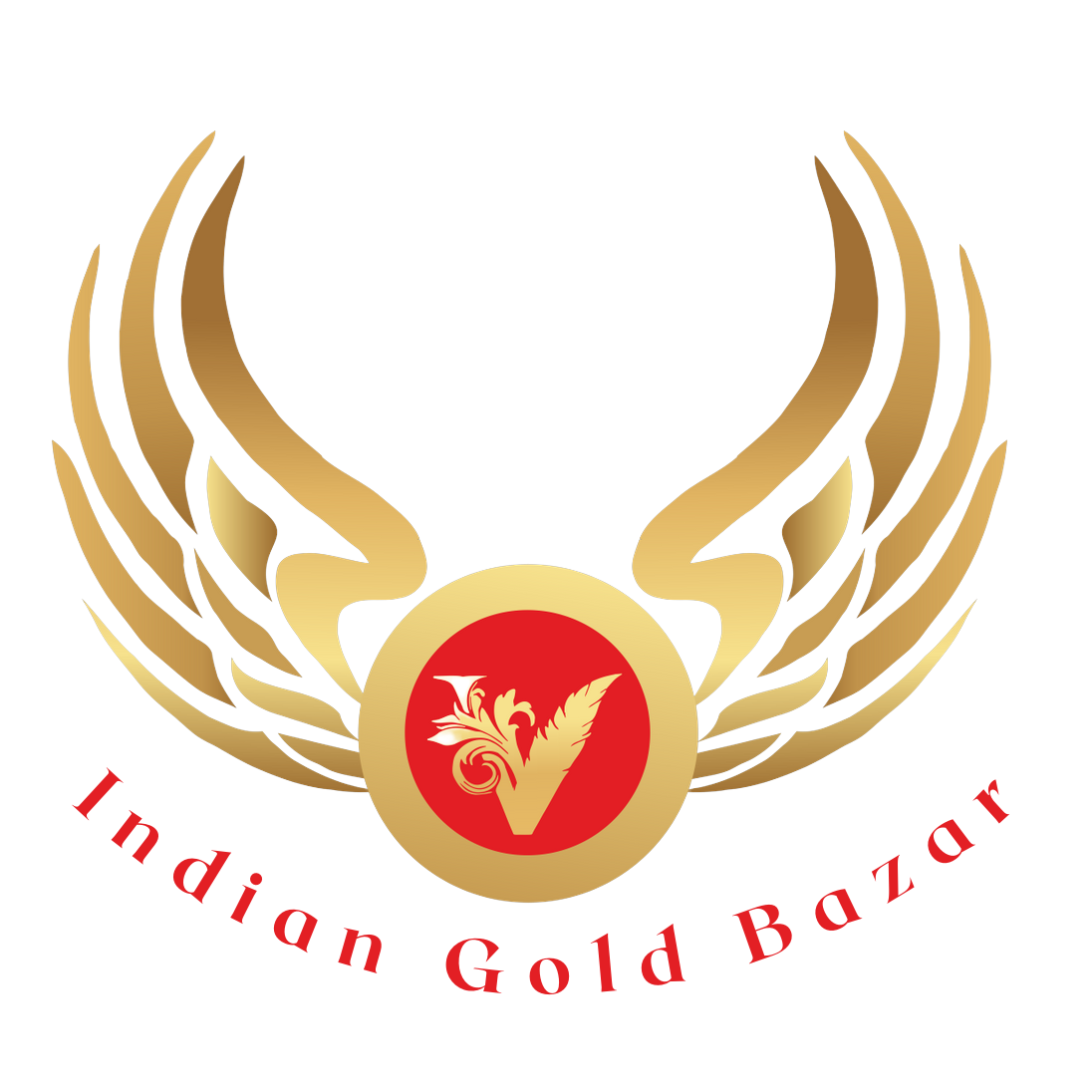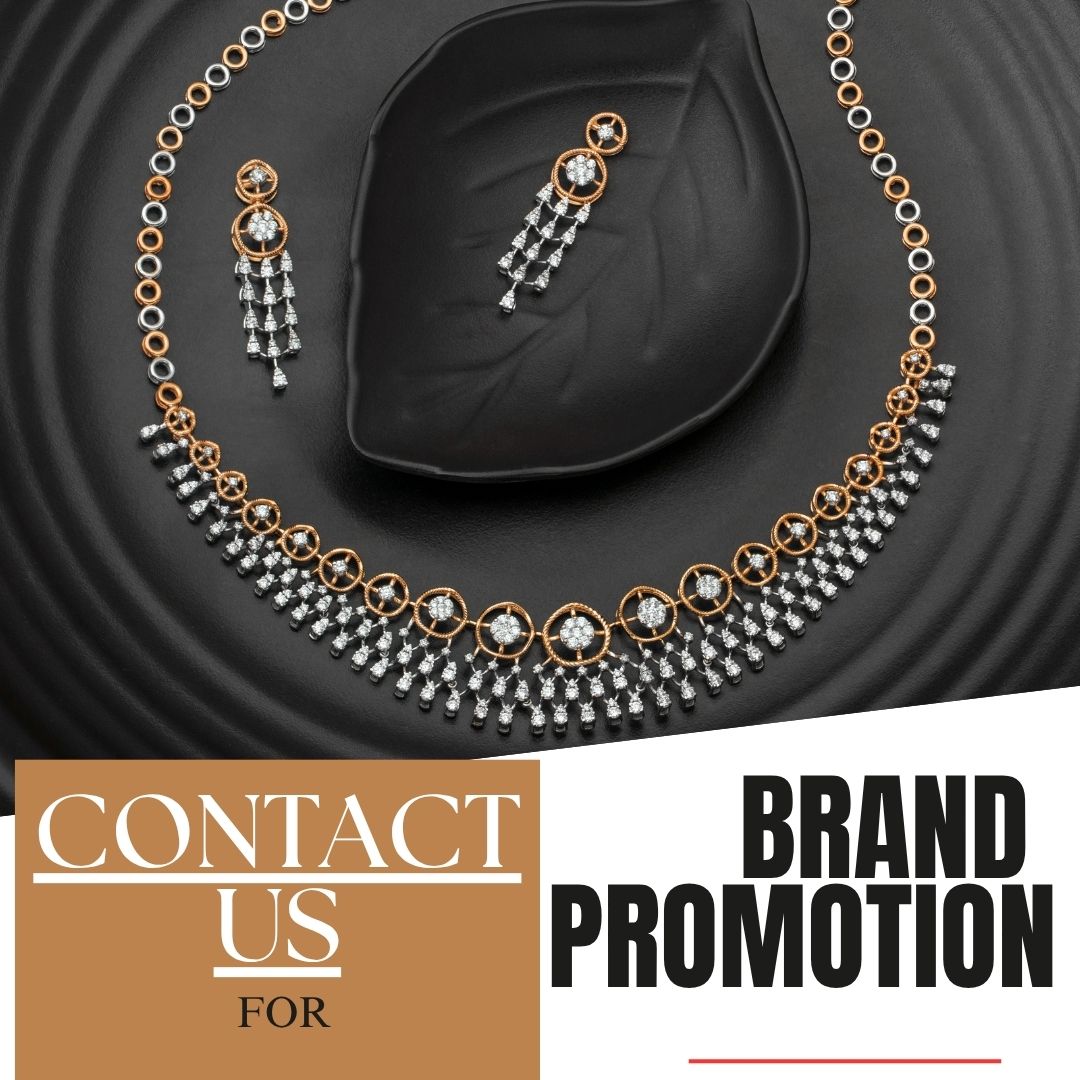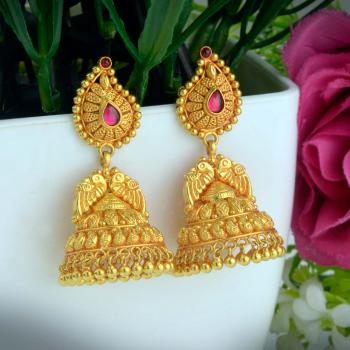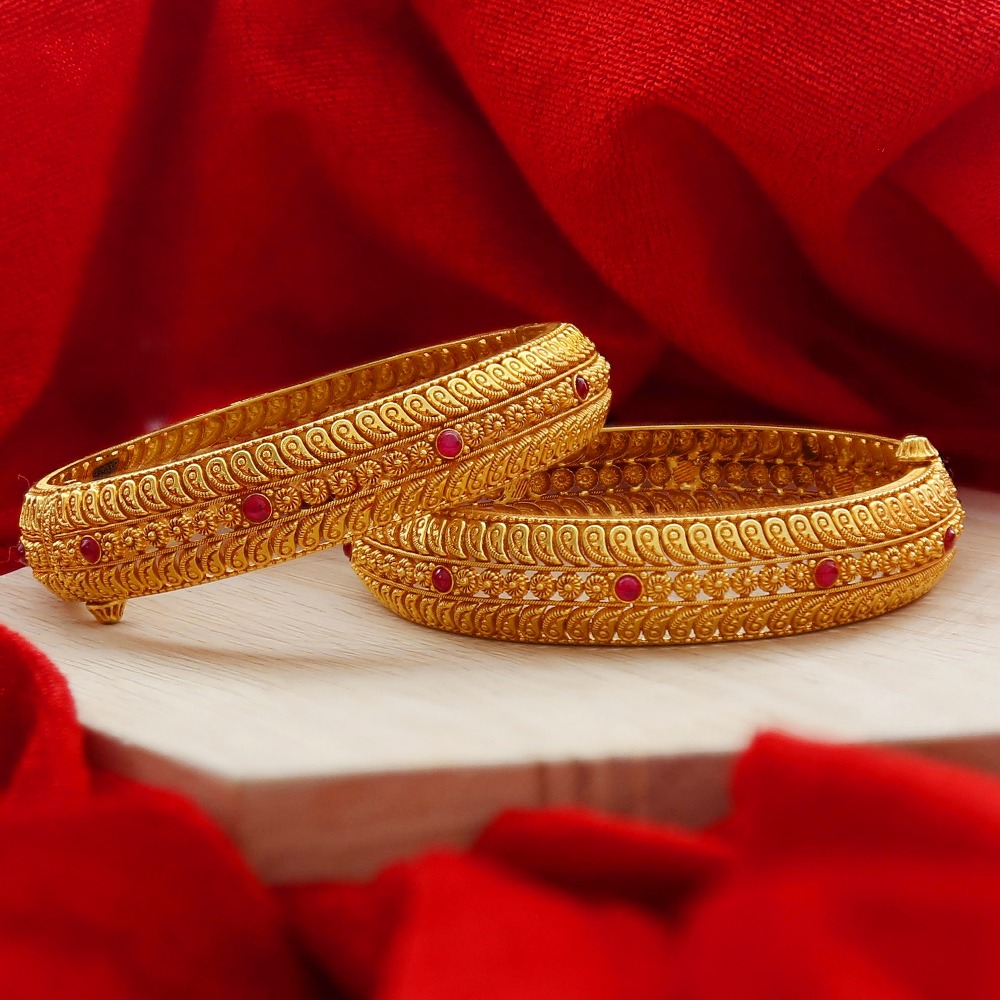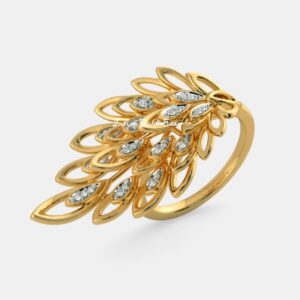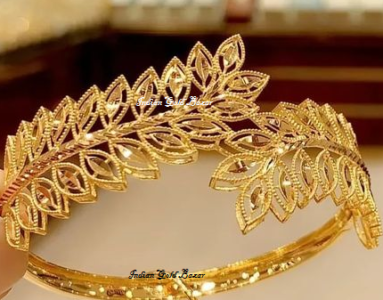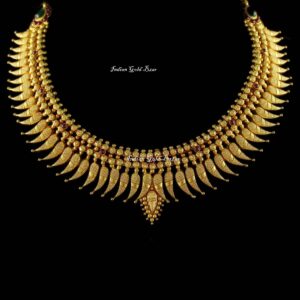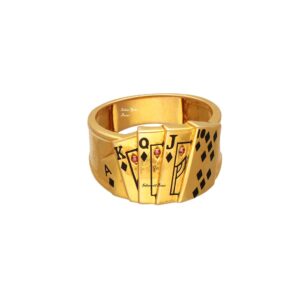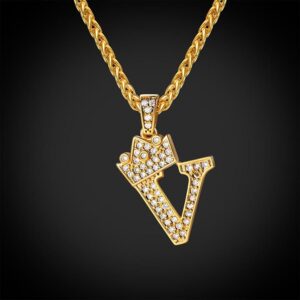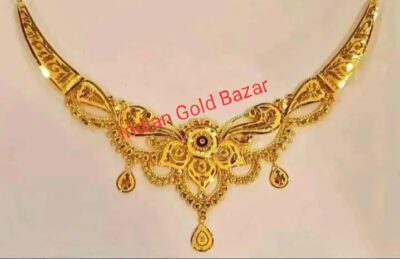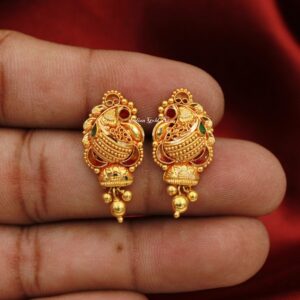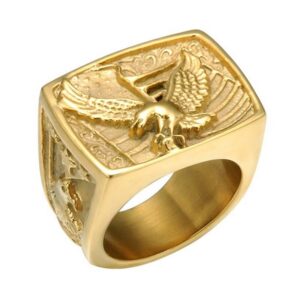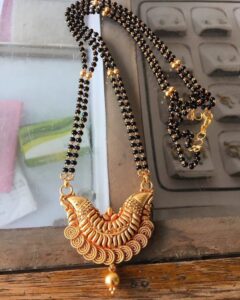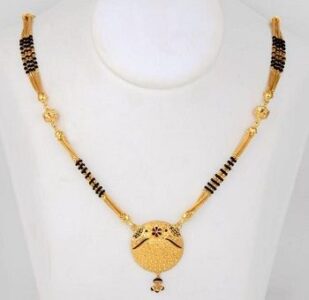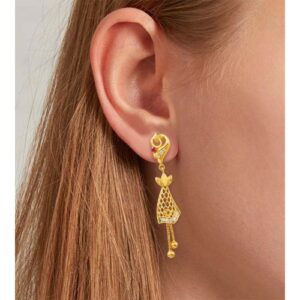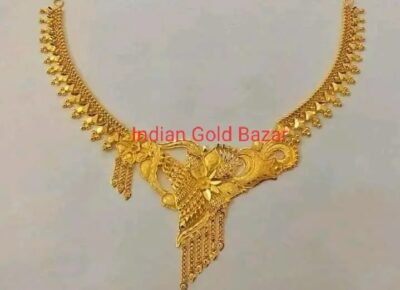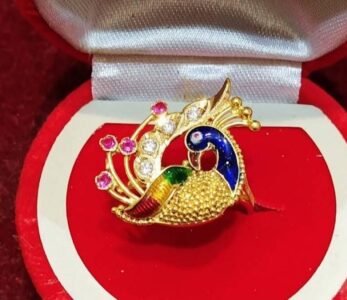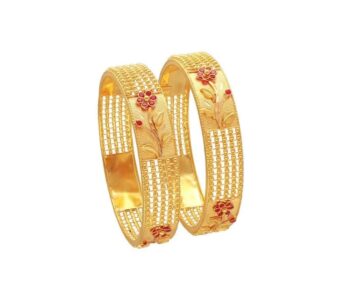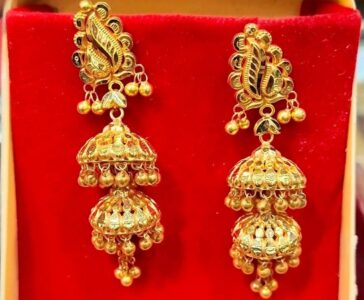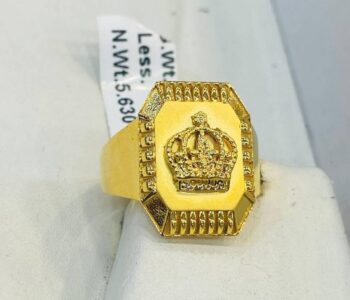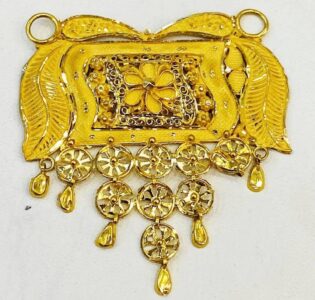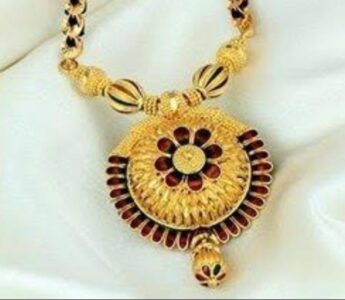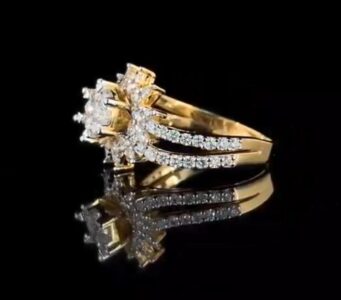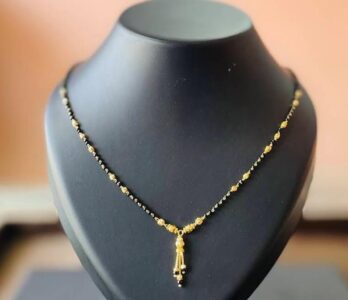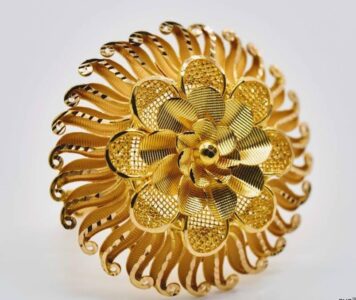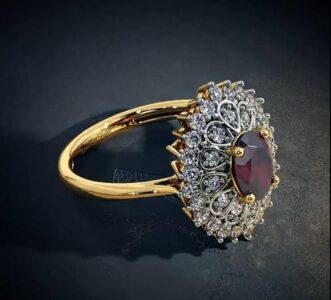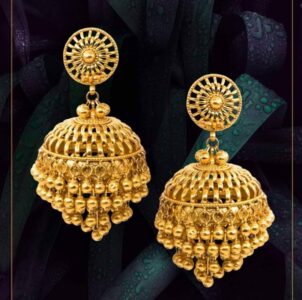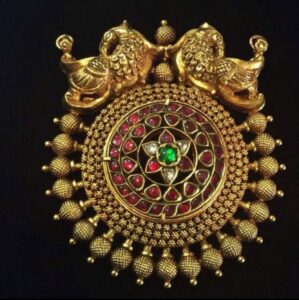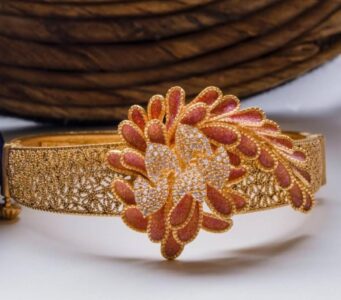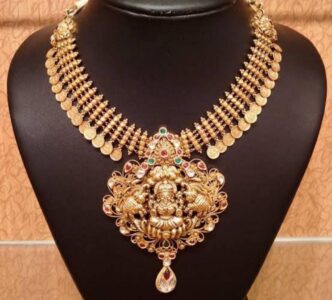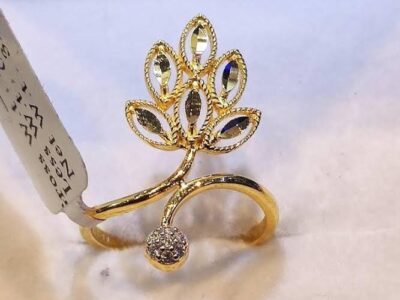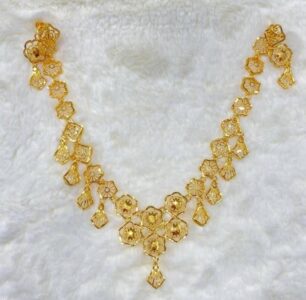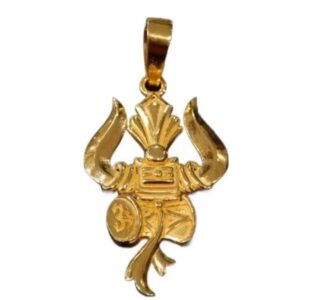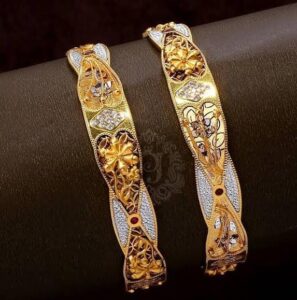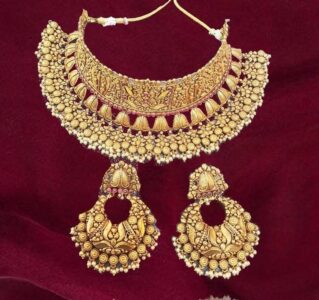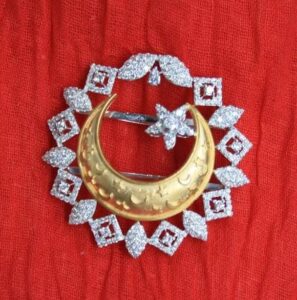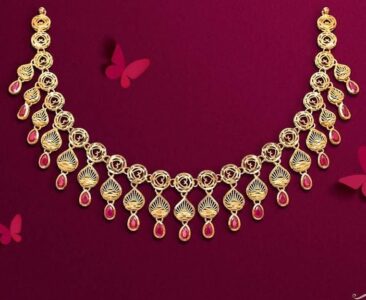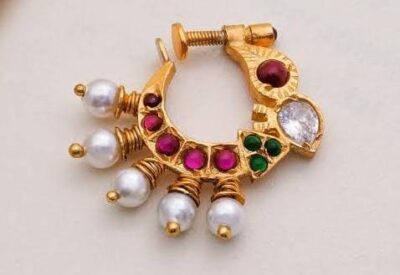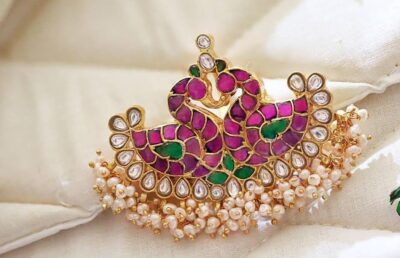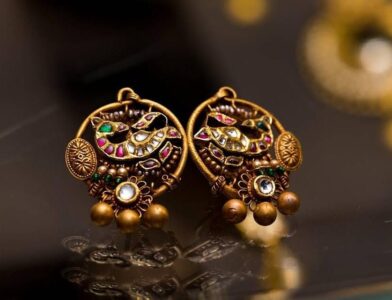- BLOG / ARTICLE
- Gold Rate/ Gold Price
- Earring/Gold Earring/Earring Design/Gold Earring Price
- Ring/ Gold Ring/ Gold Ring Design
- Necklace/Gold Necklace/ 22K Gold Necklace
- Bangle/Gold Bangle Design/18K-22K GOLD BANGLE
- Mangalsutra/Traditional gold Mangalsutra Design
- Diamond Jewelry/Diamond Rings/Diamond Necklace
Home >> Shop >> Gold Ring Page >> Gold Ring Blog







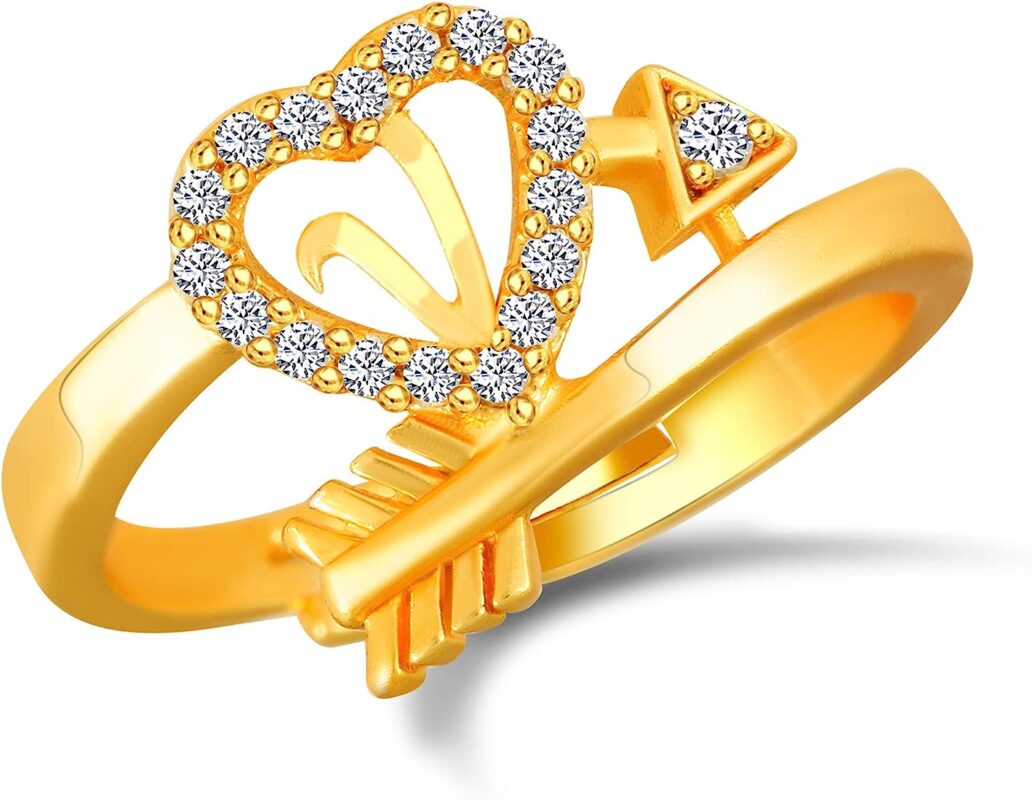
Indian Gold Rings
Indian gold rings often carry intricate designs and cultural significance. They can be adorned with various gemstones or have unique patterns that represent traditional motifs like paisleys, peacocks, or religious symbols. Some rings may hold sentimental value, passed down through generations, while others are crafted for special occasions like weddings or festivals. The purity of gold in Indian jewelry is often denoted in carats, with 22K being popular for its balance between durability and luster. Are you looking for information about specific types of Indian gold rings or anything in particular?
Gold ring for women
A gold ring for women can be a beautiful and timeless accessory. When choosing a gold ring, there are several factors to consider, including the type of gold, design, and any gemstones that may be incorporated. Here are some considerations to help you find the perfect gold ring for a woman:
Type of Gold:
Yellow Gold: Classic and traditional, yellow gold is a popular choice for many.
White Gold: A contemporary option that complements various styles.
Rose Gold: A trendy and romantic choice with a pinkish hue.
Design:
Solitaire: A single gemstone, like a diamond, as the centerpiece.
Three-Stone: Symbolizing the past, present, and future with three stones.
Eternity Band: Diamonds or gemstones encircle the entire band.
Vintage/Art Deco: Intricate designs inspired by different eras.
Gemstones:
Diamonds: Classic and timeless, diamonds are a popular choice.
Colored Gemstones: Sapphires, rubies, emeralds, or other colorful stones add vibrancy.
Birthstones: Consider a ring featuring the recipient's birthstone for a personal touch.
Setting:
Prong Setting: The gemstone is held in place with metal prongs.
Bezel Setting: The gemstone is surrounded by a metal rim for a secure fit.
Pavé Setting: Small diamonds are set closely together, covering the surface.
Band Style:
Plain Band: A simple, unadorned band for a minimalist look.
Textured Band: Adds visual interest with patterns or textures.
Engraved Band: Personalize the ring with meaningful engravings.
Size and Fit:
Ensure you know the correct ring size. You can discreetly measure another ring she owns or ask a close friend or family member for help.
Budget:
Establish a budget range to help narrow down your options.
Personal Style:
Consider the recipient's personal style and preferences when selecting a ring design.
Gold ring designs for men
Certainly! There are countless gold ring designs for women, ranging from classic and simple to intricate and contemporary. Here are some popular gold ring designs that women often find appealing:
Solitaire Ring:
A single, prominent gemstone (often a diamond) set on a gold band.
Three-Stone Ring:
Three stones symbolizing the past, present, and future, set on a gold band.
Eternity Ring:
A band with gemstones encircling it, often diamonds, representing eternal love.
Halo Ring:
A central gemstone surrounded by a halo of smaller diamonds or gemstones.
Vintage-Inspired Ring:
Rings with intricate designs inspired by different historical eras.
Stackable Rings:
Delicate gold rings that can be stacked on the same finger for a trendy look.
Twisted Band Ring:
A unique design featuring a twisted or braided gold band.
Pave Setting Ring:
Small diamonds set closely together, covering the surface of the ring.
Filigree Ring:
Rings with intricate lace-like patterns or detailing on the band.
Pearl Ring:
A gold ring featuring a lustrous pearl as the centerpiece.
Contemporary Geometric Ring:
Rings with modern, geometric shapes and clean lines.
Nature-Inspired Ring:
Rings featuring designs inspired by flowers, leaves, or other elements of nature.
Cocktail Ring:
Large, statement rings often featuring bold designs and vibrant gemstones.
Midi Ring:
Smaller rings designed to be worn on the middle phalanx of the finger.
Infinity Ring:
A ring with the infinity symbol, representing eternal love and commitment.
Gold ring design for female
When it comes to designing a gold ring for a female, there are various styles and preferences to consider. Here are a few design ideas that you can consider:
Classic Solitaire Ring:
A timeless and elegant design featuring a single, prominent gemstone (diamond, sapphire, or other precious stones) set on a simple gold band.
Vintage-Inspired Ring:
Consider a design that incorporates vintage elements, such as intricate filigree, engraving, or a halo of smaller stones around the central gem.
Nature-Inspired Design:
Create a ring with floral or nature-inspired motifs. This could include flower-shaped settings, leaf patterns, or even a vine-like band.
Three-Stone Ring:
Choose a design with three stones to symbolize the past, present, and future. This style can include a variety of gemstone shapes and sizes.
Pave Band Ring:
Opt for a ring with a band that is adorned with small pave-set diamonds or other gemstones, adding a touch of sparkle to the entire ring.
Modern Minimalist Ring:
For a sleek and contemporary look, go for a minimalist design with clean lines, a smooth band, and perhaps a subtle geometric element.
Colored Gemstone Ring:
Instead of a traditional diamond, consider using a colored gemstone (such as emerald, ruby, or sapphire) as the focal point for a unique and vibrant look.
Custom Initials or Birthstone Ring:
Create a personalized touch by incorporating initials or birthstones into the design. This adds sentimental value to the ring.
Infinity Symbol Ring:
Design a ring with an infinity symbol, representing eternal love and commitment. This can be integrated into the band or as a separate element.
Filigree Design:
Choose a ring with intricate filigree work, creating a delicate and feminine appearance. This can be combined with other design elements for a unique look.
Indian gold rings design
Indian gold ring designs encompass a wide array of styles, each with its own cultural or regional influences. Here are some popular Indian gold ring designs:
Temple Rings: These designs are inspired by temple architecture, featuring intricate carvings and motifs reminiscent of ancient temples.
Kundan Rings: Kundan is a traditional form of Indian gemstone setting. Rings with Kundan work usually feature a central gemstone surrounded by gold foils or intricate metalwork.
Antique Rings: These rings often have an antique finish with elaborate designs, giving them a vintage look. They might include filigree work or engraved patterns.
Polki Rings: Similar to Kundan, Polki rings use uncut diamonds instead of gemstones, often set in intricate gold designs.
Meenakari Rings: Meenakari is the art of enameling metal surfaces. Rings with Meenakari work have vibrant colored enamel detailing on the gold surface.
Traditional Band Rings: These rings might have symbols or patterns that hold cultural significance, like auspicious motifs or religious symbols.
Contemporary Designs: Modern Indian gold rings blend traditional elements with contemporary styles, often featuring sleeker designs or incorporating fusion aesthetics.
Bridal Rings: Specifically crafted for weddings, these rings are often more elaborate, featuring intricate designs, often with multiple gemstones or ornate detailing.
These designs showcase the rich cultural heritage and craftsmanship present in Indian gold rings, making them not just accessories but also embodiments of tradition and artistry.
North Indian gold rings design
North Indian gold ring designs showcase a distinct aesthetic influenced by the region's culture and traditions. Here are some prominent North Indian gold ring designs:
Navratna Rings: These rings feature nine different gemstones representing the nine planets in Vedic astrology. Each gemstone holds astrological significance and is set in a specific arrangement.
Jadau Rings: Jadau is a traditional jewelry-making technique involving embedding uncut gemstones (polki) into gold, often with intricate enamel work on the reverse side.
Rajasthani Rings: Reflecting the vibrant culture of Rajasthan, these rings often boast elaborate designs, filigree work, and motifs inspired by the region's architecture and folklore.
Punjabi Rings: These designs may incorporate symbols representing Punjabi culture, such as the use of kalire (a type of bridal accessory) motifs, cultural symbols, or personalized engravings.
Kundan Rings: Kundan work is popular across North India, featuring gold foil setting with precious and semi-precious gemstones in elaborate designs.
Pahadi Rings: Designs from the Himalayan regions might feature nature-inspired motifs like flowers, leaves, or symbols representing the local culture.
Mughal-inspired Rings: North Indian jewelry is often influenced by the Mughal era, showcasing intricate carvings, symmetrical patterns, and use of pearls, emeralds, and other precious gemstones.
Fusion Designs: Modern North Indian gold rings often fuse traditional elements with contemporary styles, blending regional aesthetics with modern sensibilities.
These designs vary in intricacy, symbolism, and craftsmanship, showcasing the rich cultural heritage of North India in their unique and ornate patterns.
South Indian gold rings design
South Indian gold ring designs carry a distinct and traditional flair, often reflecting the cultural richness of the region. Here are some notable South Indian gold ring designs:
Temple Rings: Inspired by the intricate architecture of South Indian temples, these rings feature detailed carvings of gods, goddesses, or temple motifs like gopurams (temple towers) and intricate patterns.
Nakshi Rings: Nakshi work involves intricate engraving on gold surfaces, often depicting mythological figures, traditional patterns, or nature-inspired designs.
Mango Mala Rings: These rings incorporate the mango motif, a symbol of fertility and prosperity, arranged in a mala (garland) style around the band.
Peacock Rings: Peacock motifs are prevalent in South Indian jewelry, symbolizing grace and beauty. Rings might feature peacock-inspired designs or engravings.
Coin Rings: Some designs incorporate ancient coin replicas or motifs inspired by ancient coins, reflecting the historical heritage of South India.
Kempu Rings: These rings are adorned with Kempu stones (red stones similar to rubies) often set in intricate designs, known for their vibrant red color.
Lakshmi Rings: Featuring images or engravings of Goddess Lakshmi, these rings symbolize wealth, prosperity, and auspiciousness.
Tamil Nadu Temple Rings: Specific to Tamil Nadu, these rings might showcase the cultural heritage of the region, featuring symbols like the Nandi bull, temple chariots, or motifs from the ancient Chola and Pandya dynasties.
Antique Finish Rings: Rings with an antique finish, often with intricate patterns and textures, are also popular in South India.
These designs highlight the craftsmanship, symbolism, and cultural significance deeply embedded in South Indian jewelry traditions, making them not just adornments but also carriers of heritage and beliefs.
Chinese gold rings design
Chinese gold rings often reflect a blend of traditional symbolism, cultural motifs, and modern design elements. Here are some common characteristics and designs found in Chinese gold rings:
Lucky Symbols: Chinese culture is rich in symbolism. Rings may feature auspicious symbols like the dragon, phoenix, longevity symbols, Fu (blessing), Shou (longevity), or symbols representing harmony and prosperity.
Jade Accents: In Chinese jewelry, jade holds immense cultural significance. Gold rings might incorporate jade stones or accents, as jade is believed to bring good luck, health, and protection.
Filigree and Intricate Patterns: Chinese gold rings often feature intricate filigree work, detailed patterns, or craftsmanship inspired by traditional Chinese architecture or art.
Zodiac Rings: Rings might incorporate designs related to the Chinese zodiac signs, representing each animal of the zodiac cycle.
Embellishments Inspired by Nature: Some designs incorporate elements from nature, such as floral motifs, bamboo patterns, or imagery of birds, representing beauty, resilience, and grace.
Modern Minimalism: Contemporary Chinese gold ring designs might lean towards minimalist styles, focusing on clean lines, sleek designs, and subtle nods to traditional Chinese motifs.
Engravings and Inscriptions: Rings may feature inscriptions or engravings of auspicious phrases, poetry, or characters symbolizing good fortune, love, or blessings.
Symbolic Shapes: Circular shapes, representing harmony and eternity, are often featured in Chinese gold ring designs. Rings might also incorporate square shapes symbolizing stability and balance.
Chinese gold rings not only serve as fashionable accessories but also embody cultural values, traditions, and beliefs, making them significant beyond their aesthetic appeal. The designs often encapsulate the rich tapestry of Chinese history, symbolism, and artistic expression.
American gold rings design
American gold ring designs encompass a wide spectrum influenced by diverse cultural backgrounds, historical periods, and contemporary styles. Here are some prevalent American gold ring designs:
Classic Solitaire Rings: These rings feature a single gemstone, often a diamond, set on a gold band. The design is timeless and elegant, focusing on the beauty of the central stone.
Vintage and Art Deco Rings: Reflecting styles from the early 20th century, Art Deco rings feature geometric shapes, intricate detailing, and often incorporate colored gemstones or diamonds.
Nature-Inspired Rings: Designs may feature elements from nature such as floral motifs, leaves, vines, or animal-inspired designs, symbolizing growth, beauty, and connection to the natural world.
Western and Cowboy Motifs: Rings might incorporate symbols from Western culture, like horseshoes, cowboy hats, or Western-style engravings, reflecting the heritage of the American West.
Patriotic Themes: Some designs might incorporate patriotic symbols like the American flag, stars and stripes, or eagles, expressing pride in American identity.
Personalized and Custom Rings: American jewelry often involves personalized or custom designs, incorporating initials, names, or significant dates, making each ring unique and meaningful.
Contemporary and Minimalist Designs: Modern American gold rings might focus on simplicity, clean lines, and minimalist aesthetics, catering to those preferring sleek and understated jewelry.
Influence from Native American Culture: Designs might draw inspiration from Native American art, incorporating tribal motifs, turquoise stones, or patterns reflecting indigenous cultures.
American gold ring designs are diverse, reflecting the country's multicultural heritage and individualistic styles. They range from classic and timeless to bold and culturally significant, catering to a wide array of preferences and tastes.
Arab gold rings design
Arab gold ring designs often blend intricate craftsmanship with cultural symbolism, creating pieces that hold significant meaning. Here are some prevalent Arab gold ring designs:
Calligraphy Rings: Rings might feature Arabic calligraphy, showcasing verses from the Quran, prayers, or words symbolizing blessings, faith, or love.
Filigree and Engraved Designs: Arab gold rings often exhibit detailed filigree work, intricate engravings, or patterns inspired by Islamic art and architecture.
Islamic Geometry: Rings might incorporate geometric patterns inspired by Islamic art, featuring motifs like arabesques, tessellations, or intricate interlacing designs.
Hamsa and Evil Eye Motifs: Some designs feature symbols like the Hamsa (hand-shaped amulet) or the Evil Eye, believed to ward off evil and bring protection and good fortune.
Stone-Set Rings: Rings may feature precious gemstones like turquoise, onyx, or agate, often combined with gold in elaborate designs.
Dallah Rings: Inspired by the traditional Arabic coffee pot (dallah), these rings may feature miniature dallah designs or motifs representing hospitality and cultural heritage.
Personalized Rings: Arab gold rings may include personalized elements such as names, initials, or dates, adding sentimental value and significance to the piece.
Thematic Rings: Designs might draw inspiration from Arab culture and history, incorporating motifs from ancient civilizations, symbols of prosperity, or elements from Arabian folklore.
Arab gold ring designs not only showcase exquisite craftsmanship but also serve as expressions of faith, cultural identity, and heritage, embodying deep-rooted traditions and beliefs within the region.
Europe gold rings design
European gold ring designs encompass a vast array of styles influenced by different historical periods, cultural movements, and individual aesthetics. Here are some notable European gold ring designs:
Victorian Rings: Reflecting the Victorian era's romanticism, these rings often feature intricate filigree work, floral motifs, and gemstones like pearls, diamonds, or colored gemstones.
Art Nouveau Rings: Inspired by natural forms and curved lines, Art Nouveau rings may incorporate flowing designs, motifs from nature like flowers, leaves, or insects, and enamel detailing.
Art Deco Rings: Characterized by geometric shapes, bold lines, and vibrant colors, Art Deco rings often feature sleek designs, using diamonds, emeralds, rubies, and sapphires in striking settings.
Renaissance Rings: These designs might draw inspiration from the Renaissance period, showcasing intricate metalwork, religious motifs, and symbolic elements.
Edwardian Rings: Edwardian era rings often feature delicate and lacy designs, incorporating platinum and diamonds with filigree work or intricate scroll patterns.
Modern and Minimalist Designs: Contemporary European gold rings might embrace minimalist styles, focusing on clean lines, simplicity, and understated elegance.
Celtic and Nordic Rings: Reflecting cultural heritage, these rings may incorporate Celtic knots, Norse symbols, or designs inspired by ancient mythology.
Signet Rings: Historically significant, signet rings might bear family crests, initials, or symbols engraved on a flat surface, often used for sealing documents.
European gold ring designs have evolved through centuries, each period leaving its distinct mark on jewelry styles. From ornate and intricate historical designs to sleek and contemporary styles, European rings showcase a diverse range of influences and craftsmanship.
Russian gold rings design
Russian gold ring designs often reflect a blend of traditional craftsmanship, cultural influences, and contemporary styles. Here are some prevalent Russian gold ring designs:
Orthodox Christian Symbolism: Rings might feature religious symbols from the Orthodox Christian faith, such as crosses, icons, or depictions of saints, reflecting spiritual significance.
Matryoshka or Russian Doll Motifs: Some designs incorporate motifs inspired by the famous Russian nesting dolls, known as Matryoshka dolls, featuring nested or layered designs.
Filigree and Enamel Work: Russian gold rings may showcase intricate filigree work, often combined with vibrant enamel detailing, a technique known as "finift," creating colorful and detailed designs.
Fabergé-inspired Designs: Inspired by the renowned Fabergé eggs and jewelry, these rings might feature intricate metalwork, gemstones, and detailed craftsmanship.
Nature-Inspired Designs: Rings may incorporate motifs from Russian nature, such as floral designs, animals like bears or wolves, or elements representing the countryside.
Soviet Era Influence: Some designs might draw inspiration from the Soviet era, incorporating motifs or designs reflecting the country's historical and cultural milestones.
Modern and Minimalist Styles: Contemporary Russian gold rings might embrace modern and minimalist aesthetics, focusing on clean lines, simplicity, and innovative designs.
Russian gold ring designs often reflect the country's rich history, cultural heritage, and artistic traditions, making them significant beyond their aesthetic appeal.
Gold rings related topic
If you're considering SEO topics related to gold rings, you could consider various angles that people might search for online:
"Trends in Gold Ring Designs": Create content around the latest trends in gold ring styles, incorporating keywords for popular designs like minimalist, vintage-inspired, or modern gold rings.
"How to Choose the Perfect Gold Ring": Write a guide that focuses on factors to consider when buying a gold ring—like quality, purity, styles, and occasion-based suggestions—to attract those looking for buying advice.
"Caring for Your Gold Rings": Discuss maintenance tips, cleaning methods, and ways to preserve the shine and durability of gold rings. This could include keywords related to cleaning solutions, DIY care, and professional maintenance.
"Symbolism of Gold Rings in Different Cultures": Explore the significance of gold rings in various cultures and traditions. Use keywords related to specific cultural references to attract a wider audience interested in symbolism and meanings.
"Gold Ring Etiquette for Different Occasions": Create content around when and how to wear gold rings for different events or occasions—weddings, engagements, everyday wear, etc. Use keywords related to etiquette and occasions.
"Innovative Uses of Gold in Ring Making": Discuss unique manufacturing processes, innovative designs, or technology used in creating gold rings. This could attract audiences interested in craftsmanship and technological advancements.
"Customizing Gold Rings: Creating Your Unique Piece": Explore the process of customizing gold rings, including design inspiration, working with jewelers, and the overall personalized experience. Use keywords related to customization and bespoke jewelry.
These topics can cater to different user intents—whether they're seeking information, looking to purchase, or simply exploring the world of gold rings. Remember, incorporating relevant keywords naturally into your content can significantly boost its visibility and reach through search engines.
"Ultimate Guide to Choosing the Right Gold Ring: Quality, Styles, and Occasions"
This comprehensive guide could cover various aspects:
Gold Ring Quality: Discuss factors that determine gold quality (karats, purity), explaining terms like 24K, 18K, etc. Include information on durability, tarnishing, and hypoallergenic properties.
Styles and Designs: Detail different styles available—solitaire, eternity bands, cocktail rings, etc. Include keywords for popular styles and trends in gold ring designs.
Gemstone Settings: Explore variations in gemstone settings with gold rings—diamonds, birthstones, and other precious stones. Discuss settings like prong, bezel, pave, etc.
Occasion-Based Suggestions: Offer guidance on selecting the right gold ring for occasions like engagements, weddings, anniversaries, or everyday wear. Use keywords related to occasions and their significance.
Sizing and Fit: Provide tips on how to measure ring size accurately, including charts and methods for a perfect fit.
Care and Maintenance: Discuss cleaning methods, storage tips, and general maintenance to preserve the brilliance of gold rings. Include keywords for cleaning solutions, care routines, etc.
Expert Advice and Buying Tips: Highlight expert advice on buying gold rings, including reputable sellers, certifications, and what to look for in a trustworthy jeweler.
By addressing these key aspects, this guide can cater to different search intents—educating those seeking information, aiding potential buyers in their decision-making process, and guiding individuals on maintenance and care of their gold rings. Remember to conduct keyword research to include relevant terms and phrases that users commonly search for in this context.
"Unveiling the Timeless Elegance of Vintage Gold Rings: A Collector's Guide"
This topic can cover various aspects:
Exploring Vintage Gold Ring Styles: Discuss iconic styles and motifs popular in different eras, such as Art Deco, Victorian, Edwardian, Retro, etc. Incorporate keywords related to these specific styles.
Materials and Craftsmanship: Highlight the craftsmanship and materials used in vintage gold rings—antique gold alloys, intricate detailing, and techniques that set them apart. Use keywords related to craftsmanship and historical techniques.
Identifying Authentic Vintage Rings: Guide readers on how to authenticate and identify genuine vintage gold rings, including hallmarks, maker's marks, and characteristics typical of different time periods.
Collecting and Investing in Vintage Gold Rings: Provide insights into the world of collecting vintage rings—tips for sourcing, understanding market value fluctuations, and potential investment opportunities. Use keywords related to collecting and investing in jewelry.
Restoration and Maintenance: Discuss restoration techniques and maintenance tips specific to vintage gold rings, emphasizing the preservation of their historical value.
Stories Behind Vintage Gold Rings: Share intriguing stories or anecdotes related to famous vintage gold rings, their owners, or historical events tied to these pieces.
This topic caters to a specific audience interested in vintage jewelry, appealing to collectors, enthusiasts, and those curious about the history and allure of vintage gold rings. Including specific keywords related to vintage styles, periods, and collecting practices can enhance the content's visibility and relevance for search engine optimization.
"The Perfect Gold Ring: A Comprehensive Buying Guide for Every Budget"
This topic can cover a wide array of information:
Budget-Friendly Options: Explore affordable options for gold rings, including gold-plated, gold-filled, or lower karat gold rings, targeting keywords related to budget-friendly choices.
Value for Investment: Discuss the value proposition of higher karat gold rings or solid gold bands, highlighting their durability, long-term value, and potential as an investment. Incorporate keywords related to investment and value.
Alternative Metals and Gold Alloys: Cover alternative options such as rose gold, white gold, or gold alloys, detailing their characteristics, popularity, and appeal. Use keywords related to specific metal types.
Customization on a Budget: Offer advice on how to customize or personalize gold rings without breaking the bank, suggesting options like simpler designs, smaller stones, or creative engravings.
Comparative Shopping Tips: Provide guidance on where to find the best deals, compare prices, and assess the quality of gold rings online or in-store. Use keywords related to shopping tips and comparisons.
DIY Ring Ideas: Include DIY or handmade gold ring ideas for those interested in crafting or customizing their own jewelry. Incorporate keywords related to DIY jewelry making.
Care and Maintenance: Emphasize cost-effective maintenance tips to preserve the beauty and longevity of gold rings, targeting keywords related to affordable care routines.
By addressing different price points and providing insights into purchasing options, customization, and care, this guide can attract a diverse audience seeking gold rings while considering their budget constraints. Incorporating specific keywords related to affordability, value, and customization can enhance the content's SEO performance.
"Decoding Gold Ring Hallmarks: A Comprehensive Guide to Symbols and Meanings"
This topic could cover several aspects:
Understanding Hallmarks: Explain what hallmarks are, their significance, and the different symbols used in gold rings' hallmarks (karat marks, maker's marks, country of origin, etc.).
Interpreting Quality: Detail how these hallmarks indicate the quality, purity, and authenticity of gold rings, addressing common queries like what 14K, 18K, or 24K signifies.
Global Variations: Discuss variations in hallmarks used across different countries or regions, emphasizing keywords related to specific hallmark systems or regions.
Spotting Fake Hallmarks: Guide readers on identifying counterfeit or fake hallmarks, providing tips and insights into recognizing genuine markings versus fraudulent ones.
Hallmarks and Value: Explain how certain hallmarks might affect the value or desirability of gold rings, helping buyers make informed decisions.
Legal Regulations and Compliance: Touch upon legal aspects or regulations related to hallmarks, ensuring compliance with industry standards and consumer rights.
By diving into the specifics of hallmarks on gold rings, this content can cater to those seeking information about authenticity, quality, and the meaning behind these markings. Incorporating keywords related to hallmark interpretation, authenticity checks, and global standards can optimize this content for search engines.
The best karat of gold for a ring depends on your preferences and lifestyle. Here's a breakdown:
24K Gold: Pure gold (100% gold). It's very soft and not suitable for everyday wear due to its malleability.
18K Gold: Contains 75% gold and 25% other metals. It's durable and has a rich gold color. Great for both fine jewelry and everyday wear.
14K Gold: Comprises 58.3% gold and 41.7% other metals. It's more affordable than 18K and is durable enough for daily wear.
10K Gold: Contains 41.7% gold and 58.3% other metals. It's the most durable but has a slightly lighter gold color due to higher alloy content.
How do I choose the right style of gold ring for my hand shape?
Selecting the right style of gold ring often involves considering your hand shape and personal preferences. Here are some tips to help you choose:
Hand Shape:
Long, Slender Fingers: You can experiment with wider bands or rings with bold designs. Oval, pear, or marquise-shaped gemstones can complement your fingers.
Shorter Fingers: Opt for smaller, delicate designs that won't overwhelm your hand. Consider thinner bands or rings with elongated shapes like emerald or rectangular cuts.
Average Hand: Most ring styles can work well for average-sized hands. Consider your personal style and what makes you feel comfortable.
Ring Styles:
Solitaire Rings: Perfect for showcasing a single gemstone, they suit most hand shapes and are versatile.
Halo Rings: These feature a center stone surrounded by smaller stones, creating an illusion of a larger ring. They can complement various hand shapes.
Three-Stone Rings: Symbolic and stylish, they often represent past, present, and future. They can balance well on longer fingers.
Band Rings: For a minimalist look, consider plain or textured bands. They are versatile and suit various hand shapes.
Statement Rings: Bold, intricate designs can draw attention. Ensure they don't overpower your hand based on your finger length and hand size.
Gemstone Shape:
Round: A classic and versatile shape suitable for most hand shapes.
Oval: Elongated shape that can complement shorter fingers.
Square or Emerald-Cut: Great for longer fingers, giving a sophisticated look.
Pear or Marquise: Can elongate the appearance of fingers.
Metal Color:
Yellow Gold: Warm and traditional, it suits various skin tones.
White Gold: Contemporary and elegant, it complements cooler skin tones.
Rose Gold: Trendy and romantic, it suits many skin tones and adds a unique touch.
Wearing a gold ring while in water or during exercise is generally okay, but it's essential to consider a few factors:
Type of Gold: Pure gold (24 karats) is relatively soft and might be more prone to damage or deformation with constant exposure to water or rigorous activities. Gold alloys (mixtures of gold with other metals like copper or silver) are more durable.
Chlorine and Saltwater: Chlorine in pools or saltwater can affect metals, potentially causing discoloration or weakening of the ring over time. It's advisable to remove your ring when swimming in chlorinated pools or the ocean.
Sweat and Moisture: While exercising, sweat and moisture can accumulate under the ring, leading to skin irritation or tarnishing of the metal. It's a good idea to remove your ring during intense workouts and rinse it afterward to prevent buildup.
Maintenance: Regularly cleaning your gold ring with mild soap and water can help maintain its shine and integrity. Additionally, periodic inspections by a jeweler can ensure the setting and stones, if any, remain secure.
Ultimately, while wearing a gold ring during activities like swimming or exercising might be fine, taking it off to prevent potential damage or loss is a good practice for its long-term upkeep and to ensure it stays in good condition.
What causes skin discoloration when wearing gold rings?
Skin discoloration when wearing gold rings is commonly caused by the reaction between the metal alloys in the gold and the acids or chemicals present in your skin. Pure gold, typically 24 karats, is generally hypoallergenic and less likely to cause skin discoloration. However, most gold jewelry isn't made of pure gold but rather a mixture of gold and other metals like nickel, copper, or zinc, which are used to strengthen the gold and alter its color.
When these metal alloys come into contact with the moisture, sweat, or acids on your skin, a chemical reaction may occur, leading to the skin becoming discolored. This reaction is more prevalent in individuals who have a higher sensitivity or allergic reaction to the metals in the gold alloy. Sweat, lotions, perfumes, or other chemicals that come into contact with the ring can also exacerbate the reaction and contribute to skin discoloration.
What are the differences between yellow gold, white gold, and rose gold rings?
Yellow, white, and rose gold rings differ primarily in their composition and appearance:
Yellow Gold:
Pure gold is naturally yellow. Yellow gold rings are typically made by mixing pure gold with other metals like copper and zinc. The percentage of pure gold is measured in karats. For instance, 24-karat gold is pure, while 18-karat gold contains 75% gold and 25% other metals.
Yellow gold has a warm, classic look that's timeless and traditional. It's a popular choice for engagement and wedding rings.
White Gold:
White gold is made by mixing pure gold with white metals like nickel, palladium, or silver. It's then plated with rhodium to enhance its white color and durability.
The resulting appearance resembles platinum or silver, making it a preferred choice for those who like a more contemporary and sleek look. However, the rhodium plating can wear off over time, requiring re-plating to maintain its white hue.
Rose Gold:
Rose gold, also known as pink or red gold, is made by mixing pure gold with copper and sometimes silver. The higher the copper content, the stronger the reddish hue.
Its romantic, rosy appearance has gained popularity in recent years for its unique and vintage-inspired look. It complements various skin tones and is a distinctive choice for those seeking something different from traditional yellow or white gold.How can I tell if my gold ring is real or fake?
There are a few methods you can use to determine if your gold ring is real or fake:
Hallmarks and Stamps: Real gold jewelry often has markings that indicate its purity. Look for stamps like "14K," "18K," or "24K" which signify the gold content. "GF" stands for gold-filled, while "GP" refers to gold-plated, indicating a layer of gold over another metal.
Magnet Test: Gold is not magnetic, so if your ring is attracted to a magnet, it's likely not real gold. However, this isn't always foolproof as some fake gold alloys might not be attracted either.
Acid Test: This test involves applying nitric acid to a small scratch on the jewelry. Real gold won't react to nitric acid, but other metals will cause a reaction, like discoloration or fizzing. This test can damage the piece, so it's best performed by a professional.
Density Test: Gold is a dense metal. You can perform a simple density test by comparing the weight of the ring to its size. Real gold is heavier than most other metals of similar size.
Professional Assessment: Jewelers or appraisers have the expertise and tools to determine the authenticity of gold jewelry. They can use acid tests, electronic testers, or other methods to assess the gold content accurately.
Are there specific care instructions for gold rings with gemstones?
there are some general care instructions for gold rings with gemstones to help maintain their beauty and durability:
Regular Cleaning: Use a mild soap or detergent and warm water to clean your gold ring with gemstones. Gently scrub the ring with a soft brush to remove dirt and grime. Rinse thoroughly and pat dry with a soft, lint-free cloth.
Avoid Harsh Chemicals: Remove your ring when using household chemicals or engaging in activities like swimming in chlorinated water, as these substances can damage both the gold and the gemstones.
Storage: Store your gold ring separately from other jewelry to prevent scratching. Consider keeping it in a soft pouch or jewelry box lined with fabric to avoid friction and damage.
Regular Inspections: Periodically inspect your ring for any loose stones or damage to prongs. If you notice anything unusual, take it to a professional jeweler for assessment and repair.
Professional Cleaning: It's a good idea to have your gold ring with gemstones professionally cleaned and inspected by a jeweler at least once a year to ensure its integrity and address any potential issues early on.
Avoid Impact: Gold is a relatively soft metal, and certain gemstones can be delicate. Avoid exposing your ring to rough or impact-prone activities to prevent damage.
Handling with Care: When handling your ring, try not to touch the gemstones excessively, as oils and dirt from your fingers can accumulate and dull their appearance over time.
What's the average cost range for a gold ring?
The cost of a gold ring can vary widely based on several factors such as the purity of the gold, design complexity, additional gemstones, brand, and craftsmanship. On average, a simple 14K gold ring might range from a few hundred dollars to around a thousand dollars. However, intricate designs or rings made with higher purity gold (18K or 24K) can cost significantly more, sometimes reaching several thousand dollars or more, especially if they include diamonds or other precious gemstones. Custom-designed or designer brand gold rings can also have higher price tags.
What makes vintage gold rings special compared to modern ones?
Vintage gold rings often possess a unique charm and appeal that set them apart from modern ones in a few ways:
Design and Craftsmanship: Vintage rings often showcase intricate designs and exquisite craftsmanship that may not be commonly seen in modern mass-produced pieces. Each vintage ring might have been handcrafted, making it a one-of-a-kind piece with attention to detail.
Historical Significance: Vintage rings carry a piece of history with them. They might have been passed down through generations or come from a particular era, reflecting the styles, sentiments, and craftsmanship of that time period.
Quality of Materials: Some vintage rings might contain purer forms of gold or other materials, as jewelry-making techniques and standards might have been different in the past. This can contribute to a different aesthetic and durability compared to modern rings.
Unique Patina or Aging: Over time, gold develops a patina that gives it a unique character and appearance. Vintage rings often showcase this aged beauty, which some people find appealing.
Sentimental Value: Vintage rings often carry sentimental value due to their history, being heirlooms, or having a story attached to them. This sentimental aspect can make them extra special for the wearer.
Can I resize a gold ring, and how much does it typically cost?
gold rings can usually be resized by a jeweler. The cost of resizing a gold ring can vary depending on several factors:
Type of resizing: Making a ring smaller usually costs less than making it larger. Making a ring larger might require adding extra gold, which can increase the cost.
Gold price: The cost of gold fluctuates, so resizing costs can vary based on the current price of gold.
Complexity of the design: Elaborate or intricate designs might require more work and thus increase the cost of resizing.
Jeweler's expertise and location: Costs can vary depending on the jeweler's skill level and the region's standard pricing for such services.
What are the different types of gold ring settings for gemstones?
There are several types of gold ring settings for gemstones, each with its own unique characteristics and advantages. Here are some common ones:
Prong Setting: This is a classic setting where metal prongs hold the gemstone in place. It allows a lot of light to enter the stone, enhancing its sparkle. Prong settings can have various configurations like four-prong, six-prong, etc.
Bezel Setting: In this setting, a metal rim encircles the gemstone, holding it securely. It offers good protection to the stone and is often chosen for its sleek and modern appearance.
Channel Setting: Gemstones are set between two parallel bars of metal, creating a channel-like effect. This setting is often used for accent stones or in eternity bands where stones are set continuously around the ring.
Pavé Setting: Tiny gemstones are set closely together, almost covering the entire surface of the ring, creating a dazzling, continuous sparkle. It's a popular choice for adding extra brilliance to a ring.
Tension Setting: The gemstone appears to be suspended between the ends of the ring without any visible support. It's a modern and minimalist setting that relies on the tension of the metal to hold the stone in place.
Cluster Setting: Multiple smaller gemstones are arranged closely together to create the appearance of a larger stone. It can form various shapes and designs on the ring.
Halo Setting: A ring of smaller gemstones surrounds a central gemstone, enhancing its appearance and creating a stunning, radiant effect.
Flush Setting: The gemstone is set directly into the metal of the ring, so it sits nearly flush with the surface. This setting is durable and offers a sleek, contemporary look.
How do I choose the right band width for a gold ring?
Choosing the right band width for a gold ring depends on personal style, finger size, and comfort. Here are some considerations to help you decide:
Finger Size: Larger fingers can typically carry wider bands well, while smaller fingers might look overwhelmed by wide bands. A narrower band might be more proportional for smaller fingers.
Comfort: Wider bands cover more skin area, potentially affecting comfort, especially if you're not used to wearing rings. A narrower band might feel more comfortable, especially if you're sensitive to the feeling of something on your finger.
Style Preference: Consider your personal style. Some prefer the bold statement of a wider band, while others prefer the subtlety of a narrower band.
Matching with Other Jewelry: If you plan to wear the ring alongside other jewelry pieces like an engagement ring or other rings, consider the overall aesthetic. Sometimes, matching band widths can create a more cohesive look.
Durability: Wider bands can be more durable due to their thickness. They might be less prone to bending or warping compared to narrower bands.
Design and Detail: Some designs might look better on wider bands as they offer more space for intricate patterns or engravings. A narrower band might limit the design possibilities.
Trial and Preference: If possible, try on rings of different widths to see what feels and looks best on your finger. Your personal preference is key in making the final decision.
What's the significance of gold purity marks on rings?
Gold purity marks on rings or any gold jewelry indicate the amount of pure gold content in the piece. Gold jewelry is typically not made of pure gold because it's too soft to hold its shape; instead, it's mixed with other metals to increase its durability. The purity of gold is measured in karats (not to be confused with carats used for gemstones), with 24 karats being pure gold.
Common purity marks on gold jewelry include:
24K: This is pure gold, but it's very soft and not suitable for everyday jewelry.
18K: Contains 18 parts gold and 6 parts of another metal alloy. It's a good compromise between purity and durability.
14K: Made of 14 parts gold and 10 parts of another metal. It's more durable than 18K but has slightly less gold content.
10K: Contains 10 parts gold and 14 parts of other metals. It's the most durable but has the lowest gold content among these standards.
Can I combine different types of gold in one ring, like mixing yellow and white gold?
Mixing different types of gold, such as yellow and white gold, to create a single ring is a popular and creative choice. This blending of gold types can result in a unique and visually striking piece of jewelry. Jewelers can combine these metals through techniques like two-tone designs or by using separate sections of different gold types within the same ring. It's a fantastic way to personalize your jewelry and create something truly special.
Are there ethical considerations when buying gold rings?
There are ethical considerations when buying gold rings, largely due to the way gold is sourced and produced. Here are a few ethical concerns associated with gold:
Environmental Impact: Gold mining can lead to significant environmental degradation, including deforestation, soil erosion, and pollution of waterways with toxic chemicals used in the extraction process.
Human Rights and Labor Practices: Many gold mines, especially in developing countries, have been associated with poor working conditions, child labor, and exploitation of workers. Some mines may also have ties to armed conflict and contribute to regional instability (referred to as "conflict gold" or "blood gold").
Fair Trade and Responsible Sourcing: Ethical consumers often look for gold that has been certified as responsibly sourced, meaning it meets certain environmental and social standards. This includes supporting Fairtrade gold initiatives that ensure miners receive fair wages and work in safe conditions.
When purchasing gold rings, you can opt for:
Recycled Gold: Gold that has been reclaimed and reused, lessening the demand for newly mined gold.
Certifications: Look for certifications from organizations like the Responsible Jewellery Council or Fairtrade to ensure ethical sourcing.
What are some popular designs for men's gold rings?
Men's gold rings come in various designs, catering to different styles and preferences. Some popular designs include:
Signet Rings: These feature a flat top with an engraved design, often used to display initials, family crests, or symbols.
Band Rings: Simple and elegant, band rings can be plain or textured, featuring a smooth surface or intricate patterns.
Gemstone Rings: Some men prefer gold rings with gemstones like diamonds, sapphires, onyx, or other precious stones set into the band.
Braided or Twisted Rings: These rings showcase a unique design with intertwined gold strands, creating an intricate, textured look.
Vintage or Antique Rings: Designs inspired by different historical periods often incorporate ornate patterns, filigree work, or motifs from specific eras.
Statement Rings: Bold and eye-catching, these rings may have larger stones, unique shapes, or intricate detailing, making them stand out.
Personalized Rings: Customized rings with engravings, dates, or symbols that hold personal significance to the wearer.
How can I remove scratches from my gold ring?
You can try a few methods to remove scratches from a gold ring, depending on the depth of the scratches:
Polishing Cloth: For light scratches, a jewelry polishing cloth might suffice. Rub the surface gently to buff out minor scratches.
Mild Soap and Water: Clean the ring with mild soap and warm water. Use a soft-bristled toothbrush to gently scrub the scratches. Rinse and dry thoroughly.
Jewelry Cleaner: Soak the ring in a jewelry cleaner solution following the product instructions. This can help minimize surface scratches.
Professional Polishing: For deeper scratches, seek a professional jeweler. They have the tools and expertise to polish and refinish the ring, restoring its shine and removing more stubborn scratches without damaging the gold.
Are there specific cultural or religious customs related to wearing gold rings?
Gold rings hold significance in various cultures and religions around the world, often symbolizing different things and used in diverse customs:
Wedding Rituals: In many cultures, exchanging gold rings during wedding ceremonies symbolizes the union and commitment between spouses. This tradition is widespread in Western cultures and has been adopted in various forms in other parts of the world as well.
Religious Significance: In some religions, gold rings may hold religious significance. For instance, in Christianity, bishops and other high-ranking clergy members might wear gold rings as a symbol of their position and authority. Similarly, in Hinduism, gold rings can be a part of religious rituals or worn as a symbol of prosperity and auspiciousness.
Cultural Symbolism: In certain cultures, gold rings are seen as a symbol of wealth, status, or family heritage. They might be passed down through generations as heirlooms, signifying lineage and tradition.
Healing and Spiritual Beliefs: In alternative practices like Ayurveda and other traditional medicine systems, wearing gold rings is sometimes believed to have therapeutic effects. It's thought to balance energy and promote well-being.
Fashion and Style: Beyond cultural or religious connotations, gold rings are often worn for their aesthetic appeal and as a fashion statement. They can signify personal style, taste, or simply be a form of self-expression.
What factors affect the resale value of a gold ring?
Several factors can influence the resale value of a gold ring:
Purity of Gold: The higher the karat (purity), the more valuable the ring. 24-karat gold is the purest and most valuable.
Weight: The heavier the ring (assuming it's made of real gold), the more valuable it tends to be.
Current Market Price of Gold: The market price of gold fluctuates regularly, affecting the resale value of the ring.
Design and Brand: Some designs or brands may hold more value due to craftsmanship, uniqueness, or the prestige associated with the brand.
Condition: Wear and tear can affect the value. Well-maintained rings will generally fetch a higher resale price.
Hallmarks and Certifications: Authenticity certificates or hallmarks indicating purity can enhance the value and credibility of the gold ring.
Trends and Demand: Fashion and style preferences change, impacting the demand for certain designs or styles at any given time.
Buyer/Seller Relationship: Where you sell the ring can also influence its resale value. Some buyers may offer higher prices based on reputation or rapport.
Can I wear multiple gold rings on one finger, and are there style guidelines for doing so?
Absolutely, you can wear multiple gold rings on one finger! It's a stylish way to accessorize and express your personal taste. Here are some style guidelines to consider when stacking multiple rings on one finger:
Balance: Mix and match ring sizes for a balanced look. Try pairing a larger statement ring with smaller, daintier ones to create visual interest.
Metal Consistency: While mixing metals can be trendy, sticking to one metal type (like all gold) can create a cohesive and polished appearance.
Spacing: Don't overcrowd the finger. Leave some space between each ring to avoid a cluttered look. You want the rings to complement each other rather than look cramped.
Consider Proportions: Be mindful of the width of the band and the size of the stones or embellishments on each ring. Too many wide bands might overpower the finger, while too many delicate rings might get lost.
Mix Styles: Experiment with different styles, textures, and designs. You can combine plain bands with rings featuring stones, engravings, or unique shapes for an eclectic yet coordinated look.
Stacking Rules: There are no strict rules! Mix and match as you like. Some prefer odd numbers of rings for an asymmetrical look, while others like even numbers for a balanced appearance.
Comfort: Ensure that wearing multiple rings on one finger doesn’t compromise comfort. Rings should fit comfortably without being too tight or hindering movement.
What are the differences between solid gold, gold-filled, and gold-plated rings?
Sure, here's a breakdown of the differences:
Solid Gold Rings: These are made entirely of gold and are often the most expensive option. They are durable, don't tarnish, and retain their value well. Solid gold rings are typically stamped with a karat mark (e.g., 18k, 14k) to indicate the purity of the gold.
Gold-Filled Rings: Gold-filled rings have a base metal core (like brass or copper) covered by a thick layer of gold bonded to the surface. This layer is much thicker than gold-plated items, making gold-filled rings more durable and resistant to tarnishing. However, they are not as valuable as solid gold rings.
Gold-Plated Rings: These rings have a very thin layer of gold electroplated onto a base metal (such as brass or copper). They are more affordable but less durable than both solid gold and gold-filled rings. The thin gold layer can wear off over time, exposing the base metal underneath.
Are there specific designs or styles of gold rings that suit certain occasions better than others?
Different designs and styles of gold rings can be more suitable for various occasions based on their aesthetics and symbolism. Here are a few examples:
Engagement Rings: Solitaire rings or those with a prominent center stone surrounded by smaller diamonds or accents are popular choices. They symbolize commitment and are often designed to stand out.
Wedding Bands: Classic plain bands or ones with intricate engravings are common for wedding rings. They symbolize eternal love and are often chosen for their timeless appeal.
Formal Events: Elaborate designs with larger gemstones or unique settings can be suitable for formal occasions like galas or upscale parties. These rings may have a more extravagant and attention-grabbing style.
Everyday Wear: Simple bands, stackable rings, or minimalist designs are ideal for everyday wear. They're comfortable and versatile, suitable for various activities and settings.
Anniversary Rings: Rings designed with multiple stones to signify the years together, eternity bands, or personalized designs can be great for commemorating anniversaries.
Statement Rings: Bold, oversized designs or rings with unique shapes can serve as statement pieces for fashion-forward events or parties.
Cultural or Religious Ceremonies: Certain cultures or religions have specific designs or symbols incorporated into their rings to represent traditions, beliefs, or values.
How do I know if the gemstones in my gold ring are authentic?
Authenticating gemstones in a gold ring can involve several methods:
Certification: Check if the gemstones have a certificate of authenticity from a reputable gemological laboratory. Certificates from organizations like GIA (Gemological Institute of America), AGS (American Gem Society), or IGI (International Gemological Institute) validate the authenticity of gemstones.
Physical Examination: Examine the gemstones for flaws, imperfections, and inclusions. Natural gemstones often have unique characteristics that synthetic or fake ones may lack. Use a loupe (a small magnifying glass) to look for irregularities within the stone.
Weight and Size: Measure the gemstones' weight and dimensions. Genuine gemstones have specific densities and weights that may help differentiate them from imitations.
Heat Conductivity: Some gemstones have unique thermal properties. For instance, a diamond conducts heat differently from cubic zirconia. Tools like a thermal conductivity probe can aid in distinguishing between natural and synthetic stones.
UV Light: Certain gemstones fluoresce or exhibit specific colors under ultraviolet light. Use a UV light source to see if the stone displays any fluorescence or unique reactions.
Consult an Expert: If in doubt, seek guidance from a gemologist or a jeweler specializing in gemstones. They have the expertise and tools to authenticate gemstones accurately.
Can I wear my gold ring during pregnancy or while caring for an infant?
Wearing a gold ring during pregnancy or while caring for an infant is generally safe. Gold is a non-reactive metal, so it's unlikely to cause any skin irritation or allergic reactions. However, there are a couple of things to consider:
Swelling: During pregnancy, your fingers might swell due to fluid retention. In such cases, it's a good idea to remove any rings that might become too tight or uncomfortable.
Safety Concerns: When caring for an infant, there might be safety concerns related to jewelry. Rings with protruding stones or designs might accidentally scratch the baby, so it's advisable to be cautious and possibly remove such rings when handling infants.
What are some ways to add personal touches to a gold ring for a special occasion, like an anniversary or milestone?
Personalizing a gold ring for a special occasion can make it truly unique. Here are some ways to add personal touches:
Engraving: Consider engraving a meaningful date, initials, a special message, or a significant phrase inside or outside the band.
Gemstones: Add gemstones that hold significance, such as birthstones of loved ones or stones representing milestones in your relationship.
Custom Design: Work with a jeweler to create a custom design that incorporates symbols, patterns, or elements that are meaningful to you and your partner.
Inscriptions: Inscribing a short poem, a line from a favorite book, or a lyric from a special song can add a poetic touch.
Personal Symbolism: Include symbols or motifs that are personally significant—a meaningful symbol, an icon representing shared interests, or a cultural symbol that holds importance to both of you.
Mixing Metals: Consider mixing gold with other metals or incorporating other materials like wood or platinum for a unique contrast.
Family Heirloom: Repurpose a family heirloom, incorporating parts of it into the new ring to honor tradition and family history.
Is there a significance to the weight of a gold ring? Does it affect the quality?
The weight of a gold ring can hold significance, but it doesn't necessarily determine its quality on its own. The weight of a gold ring primarily depends on factors such as the purity of the gold, the design, and the size of the ring.
Gold purity is measured in karats, with 24 karats being the purest form (100% gold). However, pure gold is generally too soft for everyday jewelry, so it's often mixed with other metals to enhance its durability. The weight of a gold ring can be influenced by the purity and the added metals used in the alloy.
While a heavier ring might suggest a larger quantity of gold used, it's not always indicative of quality. Quality is better evaluated through factors like craftsmanship, purity (karat), design intricacy, and the overall finish. A well-crafted, durable ring made with a lower weight of gold (due to added alloys) can be of high quality and last a long time.
What are some tips for matching gold rings with other jewelry or accessories?
Matching gold rings with other jewelry and accessories can enhance your overall look and create a cohesive style. Here are some tips to help you achieve a well-coordinated and stylish appearance:
Consider the Type of Gold:
Match Metals:
If you're wearing gold rings, try to match them with other gold accessories like earrings, bracelets, and necklaces. Mixing metals can work, but it's essential to do so intentionally for a fashionable effect.
Balance Size and Style:
Pay attention to the size and style of your rings when choosing other accessories. If you have bold or intricate rings, opt for simpler bracelets or earrings to avoid a cluttered appearance.
Coordinate Gemstones:
If your gold rings feature gemstones, coordinate the colors with other jewelry or accessories. For example, if your ring has a blue gemstone, consider pairing it with earrings or a necklace that also features blue stones.
Consider the Occasion:
Match the formality of your rings with the occasion and the rest of your outfit. Delicate and subtle rings may be suitable for everyday wear, while more elaborate and statement rings could be reserved for special occasions.
Layering Rings:
If you plan to wear multiple rings on one hand, consider the overall balance. Mix different styles, but ensure they complement each other in terms of size, shape, and metal color.
Follow a Theme:
Create a cohesive theme for your accessories. If you're going for a vintage look, choose rings and other jewelry pieces that share a similar vintage or antique style.
Consider Your Outfit:
Take into account the color and style of your outfit when selecting jewelry. A monochromatic outfit might allow for more variety in your accessories, while a patterned or colorful ensemble might call for more understated jewelry.
Match with Watch:
If you wear a watch, consider matching its metal color with your gold rings for a polished and put-together look.
Personal Style:
Ultimately, let your personal style guide your choices. If you prefer a more eclectic look, feel free to experiment with mixing different styles and metals.
How do I ensure the right balance between a fashionable gold ring and one that stands the test of time?
Finding a balance between a fashionable gold ring and a timeless piece involves considering several factors. Here are some tips to help you strike that balance:
Classic Design Elements: Opt for a ring that incorporates classic design elements. Classic doesn’t have to mean boring; it can be elegant and versatile. Look for clean lines, simple shapes, and timeless motifs that have enduring appeal.
Quality Materials: Invest in high-quality materials. Choose a gold ring made from durable and enduring materials. Solid gold (14K or 18K) tends to last longer and maintain its beauty over time compared to plated or lower-quality gold.
Versatility: Seek a ring that can complement various styles and occasions. A versatile design allows you to wear it daily or for special events without feeling out of place.
Minimal Trends: While incorporating trendy elements can add flair, ensure they’re subtle and minimal. Avoid excessive detailing or designs that might quickly go out of fashion.
Personal Touch: Consider customization or personalization that holds sentimental value. Engraving, adding birthstones, or incorporating unique details can make it timeless for you personally.
Reputable Jeweler: Purchase from a reputable jeweler known for quality craftsmanship and timeless designs. They can guide you toward pieces that strike the balance between fashion and longevity.
Comfort: A timeless ring should be comfortable to wear daily. Ensure it fits well and won’t become bothersome over time.
Budget Consideration: Set a budget that allows for quality without compromising too much on price. Investing a bit more in a timeless piece might save you money in the long run, as it will endure through changing trends.
Are there any particular superstitions or beliefs associated with wearing gold rings?
there are several superstitions and beliefs associated with wearing gold rings in various cultures:
Good Luck and Prosperity: Gold is often seen as a symbol of wealth and prosperity. Wearing gold rings, especially on specific fingers like the ring finger, is believed to attract good luck and financial success.
Marital Symbolism: In many cultures, the wedding ring is traditionally made of gold. Wearing a gold ring on the ring finger of the left hand is a widely recognized symbol of marriage and commitment.
Health Benefits: Some beliefs suggest that wearing gold rings can have health benefits. It is thought to have a calming effect and balance the body's energy, particularly in traditional medicine practices like Ayurveda.
Protection and Warding Off Evil: Gold has historically been associated with protection from negative energies or evil spirits. Wearing gold rings is believed to provide a shield against harm and ward off bad luck.
Cultural and Religious Significance: In certain cultures, specific fingers on which gold rings are worn might have cultural or religious significance. For instance, in Hindu tradition, wearing a ring on the ring finger of the right hand is considered auspicious for both men and women.
Family Heirlooms and Tradition: Passing down gold rings through generations is a common practice in many families. These heirloom rings often carry sentimental value and are believed to bring blessings and good fortune to the wearer.
What are the latest advancements or trends in eco-friendly or sustainable gold ring production?
As of my last knowledge update in January 2022, I don't have real-time information on the latest advancements or trends. However, as of that time, there were several initiatives and trends in the jewelry industry focused on eco-friendly and sustainable gold ring production. Some of these trends include:
Recycled Gold: Jewelers have been increasingly using recycled gold in their designs. This involves using gold sourced from existing jewelry, electronic waste, or other recycled materials, reducing the demand for newly mined gold.
Fairtrade and Responsible Mining Practices: Consumers are becoming more aware of the environmental and social impact of mining operations. Jewelers are responding by sourcing gold from mines that adhere to responsible and ethical mining practices, such as Fairtrade gold.
Lab-Grown Diamonds and Gemstones: While not directly related to gold, the use of lab-grown diamonds and gemstones in jewelry has gained popularity as a more sustainable alternative to traditionally mined stones. This trend could potentially extend to other components of jewelry, including gold.
Transparent Supply Chains: Brands are increasingly focusing on providing transparency in their supply chains. This includes disclosing the sources of their gold and ensuring that the entire production process is environmentally and socially responsible.
Reducing Environmental Impact: Some companies are adopting environmentally friendly practices in their manufacturing processes, such as using renewable energy, minimizing water usage, and reducing overall carbon footprints.
Innovative Design Techniques: Designers are exploring new techniques to reduce the amount of metal waste in the production process. This includes using computer-aided design (CAD) and 3D printing to create more efficient designs that minimize material wastage.
What are the meanings behind different gold ring shapes, like oval, round, or square bands?
Different gold ring shapes often carry symbolic meanings, although interpretations can vary across cultures and personal preferences. Here are some common associations:
Round Bands: Circular shapes symbolize eternity, continuity, and never-ending love. They have no beginning or end, reflecting the idea of everlasting commitment and unity.
Oval Bands: Ovals are often seen as a blend of the circle and the ellipse, representing a harmonious balance between the two. They can symbolize the idea of completeness and unity, similar to round bands but with a touch of uniqueness.
Square Bands: Squares represent stability, strength, and balance. They can symbolize a strong foundation or the solidity of a relationship. Some also associate square shapes with honesty and integrity.
Other Shapes (such as Heart or Infinity): Rings in shapes like hearts symbolize love and affection. Infinity-shaped rings represent everlasting love and limitless possibilities.
Can I combine different metals, like gold and platinum, in one ring?
it is possible to combine different metals, such as gold and platinum, in one ring. This is known as a mixed-metal or two-tone ring. Jewelers often create unique and personalized designs by combining different metals to achieve a desired aesthetic or contrast.
However, there are some important considerations to keep in mind:
Compatibility: Not all metals can be easily combined due to differences in melting points and other physical properties. Gold and platinum, however, are often compatible for combination in jewelry.
Design and Aesthetics: Mixing metals can create visually appealing designs, but it's important to consider the color contrast and overall aesthetics. Some people prefer a subtle combination, while others may want a more pronounced contrast.
Durability: Different metals have varying degrees of hardness and durability. Platinum is known for its durability and resistance to wear, while gold is softer. This should be taken into account when designing the ring to ensure it withstands everyday wear.
Cost: Both gold and platinum are precious metals, but they have different price points. Platinum is generally more expensive than gold, so the cost of the final ring may be influenced by the proportions of each metal used.
Allergies: Consider any potential allergies or skin sensitivities. While gold and platinum are generally hypoallergenic, some
What's the process for custom-designing a gold ring?
Designing a custom gold ring involves several steps. Here's a general guide to the process:
Inspiration and Ideas:
Begin by gathering inspiration. Look at existing ring designs, consider the recipient's style preferences, and explore various elements you want to incorporate into the design.
Budget Determination:
Establish a budget for the custom ring. This will help guide decisions on the type of gold, gemstones, and complexity of the design.
Choose the Metal:
Decide on the type of gold you want for the ring. Common choices include yellow gold, white gold, rose gold, or a combination of metals.
Select Gemstones (if any):
If the ring will include gemstones, decide on the type, size, and quality. Consider factors such as the recipient's birthstone or any specific preferences they may have.
Find a Jeweler:
Look for a reputable jeweler or jewelry designer who specializes in custom designs. Check reviews, ask for recommendations, and review their portfolio.
Initial Consultation:
Schedule a meeting with the jeweler to discuss your ideas, preferences, and budget. Bring any sketches, images, or notes that can help convey your vision.
Sketches and Design Proposal:
The jeweler will create sketches or digital renderings based on your discussions. Review these and provide feedback until the design aligns with your vision.
CAD (Computer-Aided Design) Model:
Once the design is finalized, the jeweler may create a 3D CAD model to provide a more detailed representation of the ring. This allows for a better visualization before the actual production.
Approval and Modifications:
Review the CAD model and make any necessary modifications. Once you are satisfied, provide approval for the jeweler to proceed with the production.
Casting:
The approved design is then used to create a wax or resin model, which is used for casting. The chosen gold is melted and poured into the mold to create the ring's basic shape.
Setting Gemstones:
If the ring includes gemstones, they will be set into the metal. This requires precision to ensure the stones are secure and aligned properly.
Finishing Touches:
The ring undergoes various finishing processes, such as polishing, to achieve the desired appearance. Any additional details or engravings are added at this stage.
Final Inspection:
The completed ring is thoroughly inspected to ensure quality and craftsmanship. Any final adjustments are made if necessary.
Delivery:
Once the ring passes inspection, it is ready for delivery. The jeweler may provide a certificate of authenticity and care instructions.
Are there cultural taboos or traditions associated with wearing gold rings on specific fingers?
Cultural taboos and traditions associated with wearing gold rings on specific fingers vary across different cultures and societies. Here are a few examples:
Wedding Ring Finger:
In many Western cultures, the wedding ring is traditionally worn on the fourth finger of the left hand, known as the "ring finger." This tradition dates back to ancient Roman times when it was believed that a vein in the fourth finger, called the "vena amoris" or vein of love, directly connected to the heart.
Right-Hand Ring Finger:
In some Eastern European and South American countries, the right-hand ring finger is the customary location for wedding and engagement rings.
Religious and Cultural Significance:
In certain cultures, specific fingers may have religious or cultural significance. For example, in Indian culture, it is common for married women to wear a wedding ring on the ring finger of the left hand. In some Middle Eastern cultures, the right hand is preferred for wearing wedding rings.
Symbolism and Personal Preferences:
In addition to cultural traditions, personal preferences and symbolism play a role in ring placement. Some individuals may choose to wear rings on specific fingers based on personal beliefs, astrological considerations, or family traditions.
Symbolism of Other Fingers:
In some cultures, wearing a ring on a particular finger may convey a specific message or status. For instance, the index finger may be associated with authority or leadership, while the thumb might symbolize wealth or influence.
What are some unique ways to repurpose old or inherited gold rings?
Repurposing old or inherited gold rings can be a meaningful and creative way to give new life to sentimental jewelry. Here are some unique ideas:
Combine Multiple Rings:
If you have several gold rings, consider melting them down and creating a new, custom-designed piece that incorporates elements from each ring. This could be a unique family heirloom.
Create a Pendant or Charm:
Transform a gold ring into a pendant or charm. This can be a great way to keep the sentimental value intact while making the piece more wearable.
Convert into Earrings:
Design a Bracelet:
Combine the gold from multiple rings to craft a custom bracelet. You can opt for a simple bangle or a more complex linked design.
Incorporate Gemstones:
Engrave or Personalize:
Keep the original gold ring intact and add a personal touch by engraving initials, dates, or a special message. This way, you preserve the sentimental value while adding a unique element.
Create a Brooch or Pin:
Transform the gold into a stylish brooch or pin. This can be a versatile accessory that can be worn on clothing, scarves, or even hats.
Make a Unique Keychain:
Craft a Custom Ring:
Redesign the gold into a completely new and unique ring. You can work with a jeweler to create a custom design that suits your style while incorporating elements from the original ring.
Donate or Gift:
If the rings have significant sentimental value but aren't your style, consider donating them to a jeweler or artisan who can use the material to create something beautiful. Alternatively, you could gift the repurposed piece to a family member.
How can I differentiate between vintage-inspired and actual vintage gold rings?
Distinguishing between vintage-inspired and actual vintage gold rings can be important, especially if you're looking for authentic vintage pieces. Here are some tips to help you differentiate between the two:
Hallmarks and Stamps:
Check for hallmarks and stamps on the inside of the ring. Genuine vintage gold rings often have marks indicating the type of metal and its purity. Research these markings to determine their authenticity.
Style and Design:
Examine the overall style and design of the ring. Vintage-inspired rings may mimic certain eras, but they often incorporate modern elements. Authentic vintage rings will showcase design features, craftsmanship, and detailing consistent with the time period they originate from.
Patina and Wear:
Genuine vintage rings usually have signs of wear, patina, or tarnish. Look for subtle scratches, scuffs, or changes in color that naturally occur over time. Vintage-inspired rings may lack these authentic aging characteristics.
Gemstones and Settings:
Consider the gemstones and settings. Vintage rings may feature older cut styles, such as rose cuts or mine cuts, and may have unique settings indicative of a particular era. Modern replicas may use contemporary settings or updated versions of classic cuts.
Materials and Manufacturing Techniques:
Pay attention to the materials used and manufacturing techniques. Genuine vintage rings may have been crafted using traditional methods that differ from modern production techniques. Look for evidence of hand craftsmanship, such as irregularities and imperfections.
Provenance and Documentation:
If possible, ask for provenance or documentation that confirms the ring's age and history. This could include certificates, receipts, or any other information that traces the ring back to its origin.
Consult Experts or Appraisers:
When in doubt, seek the opinion of jewelry experts or appraisers. They can provide insights into the authenticity of the ring based on their knowledge and experience.
Research the Era:
Familiarize yourself with the characteristics of different eras. Knowing the specific design elements, popular gemstones, and metalworking techniques of a particular time period can help you identify genuine vintage pieces.
Price and Source:
Be cautious of unusually low prices for items claimed to be vintage. Authentic vintage rings, especially those with historical significance or rare features, tend to have higher value. Purchase from reputable dealers or sellers with a good track record.
What are the best practices for storing gold rings to prevent tarnishing and damage?
Storing gold rings properly is essential to prevent tarnishing and damage. Here are some best practices:
Clean Before Storage:
Clean your gold rings before storing them to remove any oils, lotions, or other substances that can contribute to tarnishing.
Avoid Exposure to Moisture:
Moisture can lead to tarnishing, so store your gold rings in a dry environment. Consider using a dehumidifier in the storage area.
Use Anti-Tarnish Strips:
Place anti-tarnish strips or tabs in the storage container. These absorb moisture and prevent tarnishing. Replace them periodically as they lose their effectiveness.
Individual Storage:
Store each gold ring separately to prevent scratching and tangling. Use soft pouches, jewelry boxes with individual compartments, or wrap them in soft, lint-free cloth.
Avoid Exposure to Air:
Airtight containers or zip-lock bags can help minimize exposure to air and slow down tarnishing. Ensure the container or bag is clean and dry before placing your gold rings inside.
Keep Away from Direct Sunlight:
Exposure to sunlight and heat can cause discoloration and damage to gemstones. Store your gold rings away from direct sunlight and heat sources.
Avoid Contact with Chemicals:
Remove your gold rings before using chemicals, such as cleaning agents, perfumes, or hairspray. Chemicals can react with the metals and gemstones, leading to tarnishing or damage.
Regular Inspection:
Periodically inspect your gold rings for any signs of tarnish, damage, or loose stones. Early detection allows for timely maintenance and prevents further issues.
Safe Location:
Choose a safe and secure location for storage, away from potential hazards. Avoid places with extreme temperature fluctuations, such as attics or basements.
Professional Cleaning and Maintenance:
Consider taking your gold rings to a professional jeweler for periodic cleaning and inspection. They can clean your rings using appropriate methods and check for any issues that may need attention.
Insurance:
Consider insuring your valuable jewelry against loss, theft, or damage. This provides an added layer of protection in case of unforeseen events.
Do different gold tones (such as yellow, white, or rose gold) complement certain skin tones better?
Yes, different gold tones can complement various skin tones differently. Here's a general guide:
Yellow Gold:
Suitable for: Yellow gold tends to complement warmer skin tones. If you have undertones that lean towards peachy or golden, yellow gold can be a great choice.
White Gold:
Suitable for: White gold is a versatile option that can complement various skin tones. It's a good choice for individuals with cool or neutral undertones.
Rose Gold:
Suitable for: Rose gold, with its warm and rosy hue, complements a wide range of skin tones. It can look especially lovely on individuals with warm or neutral undertones.
Are there any health benefits or healing properties associated with wearing gold rings?
While there is no scientific evidence to support the idea that wearing gold rings has direct health benefits or healing properties, gold has been valued for its aesthetic appeal and cultural significance for centuries. In various cultures, gold has been believed to symbolize wealth, power, and status.
It's essential to note that any perceived health benefits or healing properties associated with wearing gold rings are often rooted in cultural beliefs, traditions, or anecdotal experiences rather than scientific evidence. Some people may wear gold jewelry for personal or cultural reasons, but it's crucial to approach such beliefs with a degree of skepticism and rely on evidence-based practices for health and well-being.
What are some historical or iconic gold ring designs that have stood the test of time?
While specific gold ring designs may vary based on cultural and individual preferences, there are several historical and iconic styles that have stood the test of time:
Plain Band:
A simple, unadorned gold band has been a classic choice for wedding rings and other symbolic jewelry for centuries. Its timeless and versatile design makes it a popular choice across cultures.
Claddagh Ring:
Originating from Ireland, the Claddagh ring features a distinctive design with two hands holding a heart topped by a crown. The elements symbolize love, loyalty, and friendship, making it a meaningful and enduring choice.
Eternity Ring:
Eternity rings typically feature a continuous loop of diamonds or gemstones around the band, symbolizing everlasting love and commitment. This design has remained popular for wedding and anniversary bands.
Art Deco Rings:
Rings from the Art Deco era (1920s-1930s) often feature geometric patterns, bold colors, and intricate detailing. Art Deco rings are celebrated for their glamorous and sophisticated designs.
Signet Ring:
Signet rings have a flat bezel that is often engraved with a family crest, monogram, or other personal symbol. They have been used throughout history as a sign of status and identity.
Tiffany Setting:
The Tiffany setting, introduced by Tiffany & Co., is a classic engagement ring design characterized by a six-prong setting that lifts the diamond above the band, allowing more light to enhance its brilliance.
Victorian Era Rings:
Victorian-era rings (1837-1901) often feature intricate designs, filigree work, and symbolic motifs. Engagement rings from this era may include gemstones such as diamonds, pearls, or colored gemstones.
Buckle Ring:
Buckle rings, popular in the 19th century, feature a design that resembles a belt buckle. This symbolizes eternity and has been used as a token of commitment and loyalty.
Gimmel Ring:
Gimmel rings have two or three interlocking bands that come together to form a single ring. They were popular during the Renaissance and symbolize unity and the coming together of two individuals.
Celtic Knot Rings:
Celtic knotwork, with its intricate and endless loops, has been incorporated into ring designs, symbolizing eternal love and interconnectedness. These rings are often associated with Irish and Scottish heritage.
What is the difference between 14K and 18K gold rings?
The terms "14K" and "18K" refer to the karatage, which is a measure of the purity of gold used in jewelry. Karats are denoted by the letter "K." The main difference between 14K and 18K gold rings lies in the gold content:
14K Gold:
Gold Content: 14 karat gold is composed of 58.3% pure gold and 41.7% other metals. These other metals, often copper, silver, or nickel, are added to increase the strength and durability of the gold.
Color: 14K gold tends to be slightly less yellow than higher karatages, and it may have a slightly paler color due to the presence of alloyed metals.
18K Gold:
Gold Content: 18 karat gold is more pure, containing 75% pure gold and 25% other metals. As it has a higher gold content, it is often considered more valuable and is generally more expensive than 14K gold.
Color: 18K gold has a richer, more intense color due to its higher gold content. It is often preferred by individuals who appreciate the warm, deep hue of gold.
Considerations:
Durability: 14K gold is generally more durable and less prone to scratches and dents due to its higher alloy content. This can be an important factor to consider if the ring will be subject to daily wear and tear.
Cost: 18K gold is typically more expensive than 14K gold because of its higher gold content. The price difference can vary based on market conditions and other factors.
Allergies: Some individuals may be allergic to certain alloying metals. If you have metal allergies, it's a good idea to check the specific alloys used in the gold to ensure they are hypoallergenic.
How do I determine my ring size when buying a gold ring online?
Determining your ring size for buying a gold ring online can be done in several ways. Here are a few methods you can try:
Use a Ring Sizer:
Many jewelry stores offer free ring sizers that you can request online. They will usually send you a plastic or paper ring sizer with a set of sizes. Follow the instructions to find the size that fits you comfortably.
Visit a Local Jeweler:
Visit a local jewelry store and ask them to measure your ring size. Most jewelers will have a ring sizer and will be happy to assist you. Make sure to measure the finger on which you intend to wear the ring, as sizes can vary between fingers.
Printable Ring Sizer:
Some online jewelry retailers provide printable ring sizers. You can download and print a paper ring sizer, cut it out, and follow the provided instructions to find your size.
Measure an Existing Ring:
If you already have a ring that fits well on the same finger you plan to wear the new ring, you can measure the inside diameter of that ring. Many online charts convert these measurements to standard ring sizes.
Use a String or Strip of Paper:
Take a piece of string or a strip of paper and wrap it around the base of your finger where you plan to wear the ring. Mark the point where the string or paper meets and measure the distance with a ruler. Convert this measurement to the appropriate ring size using an online conversion chart.
Consider Comfort Fit:
Keep in mind that the fit of the ring can vary depending on the design and width. Some people prefer a looser fit for wider rings, while others like a snugger fit. Consider whether you want a standard fit or a comfort fit.
Can I wear a gold ring every day without it losing its shine?
Wearing a gold ring every day can cause it to lose some of its shine over time due to factors such as contact with skin oils, lotions, and everyday activities. However, gold is a relatively inert metal, and it does not tarnish like some other metals.
To minimize the impact on the shine of your gold ring, you can follow these tips:
Clean regularly: Clean your gold ring regularly with a mild detergent and a soft brush. This helps remove accumulated oils and dirt.
Avoid harsh chemicals: Take off your gold ring when using harsh chemicals, cleaning agents, or when swimming in chlorinated water. These substances can dull the finish and potentially damage the metal.
Remove during activities: Remove your gold ring during activities that might subject it to unnecessary wear and tear, such as heavy-duty work or sports.
Store properly: Store your gold ring in a fabric-lined jewelry box or pouch to prevent scratches and minimize exposure to air and moisture.
Polishing: Periodically, you can polish your gold ring with a jewelry polishing cloth to restore its shine.
Keep in mind that the rate at which your gold ring loses its shine can depend on the karat of gold. Higher karat gold (e.g., 18k or 24k) is softer and more prone to scratches and wear than lower karat gold (e.g., 10k). If maintaining a high shine is a top priority, you might want to choose a lower karat gold or consider other metals that are more resistant to wear.
What's the significance of wearing a gold ring on different fingers?
The significance of wearing a gold ring on different fingers can vary across cultures, traditions, and personal beliefs. While there are no universal rules, some societies and belief systems attribute specific meanings to wearing a ring on different fingers. Keep in mind that these interpretations are not universally agreed upon, and individual preferences and cultural variations play a significant role. Here are some general associations with wearing a gold ring on different fingers:
Ring Finger (Fourth Finger):
In many Western cultures, the ring finger on the left hand is traditionally reserved for engagement and wedding rings.
In some Eastern European and South American countries, the right ring finger is preferred for engagement and wedding rings.
Index Finger (Second Finger):
Wearing a ring on the index finger is often associated with authority and leadership. In some cultures, it may symbolize power and ambition.
In certain societies, wearing a ring on the index finger may indicate a desire for attention or a statement of self-expression.
Middle Finger (Third Finger):
The middle finger is less commonly associated with ring-wearing, but some people choose it for aesthetic reasons or personal preference.
In some cultures, a ring on the middle finger may symbolize balance and responsibility.
Thumb:
Wearing a ring on the thumb is often seen as a symbol of wealth and influence.
In some cultures, a thumb ring may also represent independence and individuality.
Pinkie Finger (Little Finger):
A ring on the pinkie finger can be a sign of personal style and flair.
In certain cultures, it may be associated with communication and expression.
How do I clean and maintain my gold ring to keep it looking new?
Cleaning and maintaining your gold ring can help keep it looking new and beautiful. Here are some general tips for cleaning and caring for your gold ring:
Use a Mild Cleaning Solution:
Mix a few drops of mild dish soap with warm water. You can also use a specialized jewelry cleaning solution.
Avoid harsh chemicals or cleaners that may damage the gold or gemstones.
Soak and Gently Clean:
Let your gold ring soak in the soapy water for 15-30 minutes to loosen dirt and oils.
Use a soft brush, such as a toothbrush with soft bristles, to gently scrub the ring and remove any residue.
Rinse Thoroughly:
Rinse the ring under warm running water to remove any soap residue.
Be sure to plug the drain or use a basin to avoid accidental loss of the ring.
Dry Carefully:
Pat the ring dry with a soft, lint-free cloth. Avoid using tissues or paper towels, as they can scratch the metal.
Allow the ring to air dry completely before wearing it or storing it.
Avoid Harsh Chemicals and Activities:
Remove your gold ring before engaging in activities that may expose it to harsh chemicals, such as swimming in chlorinated pools or using household cleaners.
Avoid wearing your ring when doing activities that may cause it to get scratched or damaged.
Store Properly:
When you're not wearing your gold ring, store it in a fabric-lined jewelry box or a soft pouch to prevent scratches and tarnishing.
Keep individual pieces separated to avoid scratches and tangling.
Regular Inspections:
Periodically inspect your ring for loose stones, prongs, or any signs of wear and tear.
If you notice any issues, take your ring to a professional jeweler for inspection and maintenance.
Professional Cleaning:
Consider having your gold ring professionally cleaned by a jeweler once a year. They can also check for any potential issues and provide maintenance if needed.
Are there specific cultural or symbolic meanings behind gold rings?
gold rings have held cultural and symbolic significance in various societies throughout history. Here are some common meanings associated with gold rings:
Wedding and Marriage:
In many Western cultures, gold rings are a traditional symbol of marriage. The circular shape of the ring represents eternity and the endless nature of love. The use of gold, a precious and enduring metal, further emphasizes the lasting commitment of marriage.
Status and Wealth:
Gold has been considered a valuable and precious metal for centuries. Wearing gold rings can signify wealth, social status, and prosperity. In some cultures, specific types of gold rings may be reserved for certain classes or groups within society.
Religious Symbolism:
In various religious traditions, gold rings may hold specific symbolic meanings. For example, in Christianity, a gold wedding ring is often seen as a symbol of the union blessed by God. In Hinduism, gold is considered an auspicious metal, and gold rings may be worn for religious ceremonies or as a symbol of devotion.
Ceremonial and Ritualistic Purposes:
Gold rings are often used in ceremonies and rituals to mark significant life events such as births, coming-of-age ceremonies, and religious rites. They may be passed down through generations as family heirlooms, carrying the history and traditions of the family.
Sign of Commitment and Partnership:
Gold rings can also symbolize commitment and partnership beyond marriage. They may be exchanged between friends, family members, or individuals to signify a strong bond or promise.
Decorative and Ornamental Purposes:
Gold rings are often worn for their aesthetic appeal. They can be intricate pieces of jewelry with artistic designs, gemstones, or engravings. In some cultures, certain ring designs may have specific meanings or be associated with particular events.
Symbol of Authority:
In some historical societies, gold rings were worn as a symbol of authority and power. Leaders, rulers, or individuals of high social standing may have worn gold rings to signify their status and influence.
What should I look for when buying a vintage gold ring?
Buying a vintage gold ring can be an exciting and rewarding experience, but it's important to consider several factors to ensure you make an informed and satisfactory purchase. Here are some key aspects to look for when buying a vintage gold ring:
Authenticity and Hallmarks:
Ensure that the ring is authentic and not a reproduction. Look for hallmarks or stamps on the inner side of the ring that indicate the gold content and possibly the manufacturer.
Gold Purity:
Check the gold purity, which is typically expressed in karats (e.g., 14k, 18k). Higher karat gold is softer but more valuable. Make sure the gold content matches the seller's claims.
Condition of the Ring:
Inspect the overall condition of the ring, including the band, setting, and any gemstones. Vintage rings may have signs of wear, but excessive damage or poor repairs can affect both aesthetics and durability.
Gemstone Quality:
If the ring features gemstones, assess their quality. Check for scratches, chips, or other damage. Look for vibrant colors and clarity. Vintage rings may have different cutting styles and characteristics compared to modern ones.
Design and Style:
Consider the design and style of the ring. Vintage rings often have unique and intricate designs that reflect the fashion of their era. Choose a style that appeals to your taste and complements your preferences.
Ring Size:
Ensure that the ring is the right size for the intended wearer. Resizing vintage rings, especially those with intricate designs or engraved patterns, can be challenging and may affect the overall aesthetics.
Provenance and History:
If possible, learn about the ring's history and provenance. Documentation or a reputable seller can provide information about the ring's origin, previous owners, or any historical significance.
Settings and Mountings:
Examine the settings and mountings of any gemstones. Loose or damaged settings can increase the risk of losing stones. Ensure that the stones are securely set.
Seller Reputation:
Buy from a reputable and trustworthy seller. Read reviews, check certifications, and ask for recommendations to ensure you are dealing with someone who has a good track record in selling vintage jewelry.
Budget:
Set a budget for your purchase. Vintage gold rings can vary widely in price depending on factors like gold purity, gemstone quality, and historical significance. Knowing your budget will help narrow down your options.
How can I tell if a gold ring is authentic and not fake or plated?
Authenticating a gold ring and distinguishing it from fake or plated ones requires a careful examination of various factors. Here are some steps you can take to determine the authenticity of a gold ring:
Look for Hallmarks:
Genuine gold jewelry often carries hallmarks or stamps that indicate the purity of the gold. Common hallmarks include "24K" for pure gold, "18K" for 18 karats, "14K" for 14 karats, and so on.
Hallmarks may also include the manufacturer's mark, which can be researched to verify authenticity.
Check for Discoloration:
Gold does not tarnish or corrode, so if you notice any signs of discoloration, it might be an indication of a fake or plated ring.
Verify Weight:
Real gold is dense and heavy. Compare the weight of the ring to that of a similar-sized object made of a known metal. Be cautious if the ring feels unusually light.
Perform a Nitric Acid Test:
This test involves applying a small drop of nitric acid to an inconspicuous part of the ring. Real gold will not react to nitric acid, while base metals or gold-plated items will show a reaction.
Magnet Test:
Gold is not magnetic, so if the ring is attracted to a magnet, it is likely not pure gold.
Use a Magnetron Gold Tester:
This electronic device measures the electrical conductivity of the metal, which can help determine its authenticity.
Professional Appraisal:
Consider seeking the expertise of a professional jeweler or appraiser. They have the knowledge and tools to accurately assess the authenticity and value of the gold ring.
Check for Wear and Tear:
Authentic gold tends to resist wear and tear better than fake gold or plated items. If you notice signs of peeling, chipping, or flaking, it may be an indication that the ring is not genuine.
Compare with Known Authentic Pieces:
If possible, compare the ring in question with a known authentic gold piece. Pay attention to details like color, weight, and craftsmanship.
Price and Source:
If the price seems too good to be true, it probably is. Be cautious when dealing with sellers offering gold at significantly lower prices than the market average.
Purchase from reputable and trusted jewelers or sources.
What are the popular styles or trends in gold rings for weddings and engagements?
As of my last knowledge update in January 2022, popular styles and trends in gold rings for weddings and engagements may have evolved, but I can provide some general insights based on trends up to that point. Keep in mind that trends can vary over time and may be influenced by cultural preferences, fashion changes, and individual tastes. Here are some trends that were popular:
Vintage and Antique Designs: Many couples were opting for rings with a vintage or antique look, featuring intricate details, filigree work, and often inspired by designs from different eras.
Mixed Metals: Combining different types of gold (white gold, yellow gold, rose gold) in one ring was gaining popularity. This trend allowed for a unique and personalized look.
Nature-Inspired Designs: Rings with nature-inspired elements, such as floral motifs, leaves, or vines, were becoming more prevalent. These designs often added a romantic and organic touch.
Unique Gemstones: While gold remains a classic choice, some couples were incorporating unique gemstones alongside or instead of traditional diamonds. Sapphires, morganite, and other colorful stones were gaining popularity.
Customization and Personalization: Many couples were choosing to design custom rings to reflect their personal style and preferences. This could include engraving, unique shapes, or adding special symbols.
Minimalistic Bands: Some couples preferred simpler and more minimalistic gold bands without intricate designs. These timeless styles often focused on the beauty of the metal itself.
Stackable Rings: Stackable rings, which allow for mixing and matching different bands on the same finger, were becoming a trendy choice. This style provided flexibility for creating a unique and personalized look.
Art Deco Influence: Rings with Art Deco-inspired designs, characterized by geometric shapes, bold lines, and symmetry, were also gaining popularity.
Elongated Shapes: Rings with elongated shapes, such as oval or marquise-cut diamonds, were becoming more fashionable, offering a modern and elegant twist.
Can I customize a gold ring with my own design or engraving?
Yes, you can typically customize a gold ring with your own design or engraving. Many jewelers offer customization services to meet the specific preferences and tastes of their customers. Here's what you can generally expect when it comes to customizing a gold ring:
Design:
You can work with a jeweler to create a custom design for your ring. This may involve sketching ideas, discussing your preferences, and making decisions about the overall style, shape, and details of the ring.
Materials:
Specify the type and karat of gold you want for your ring. Common choices include 14k or 18k yellow gold, white gold, or rose gold.
Gemstones:
If your design includes gemstones, you can choose the type, size, and quality of stones you want. Common gemstone choices for rings include diamonds, sapphires, rubies, and more.
Engraving:
Most jewelers offer engraving services. You can engrave meaningful dates, names, or personal messages inside the ring. The style and font of the engraving can often be customized as well.
Sizing:
Ensure that the ring is sized to fit your finger correctly. The jeweler will take measurements to ensure a comfortable and accurate fit.
Cost and Timeline:
Customization can affect the cost of the ring, so discuss pricing and payment options with the jeweler. Additionally, inquire about the timeline for the completion of the custom design.
Communication:
Maintain open communication with the jeweler throughout the customization process. They may provide you with updates, design drafts, or samples to ensure the final product meets your expectations.
